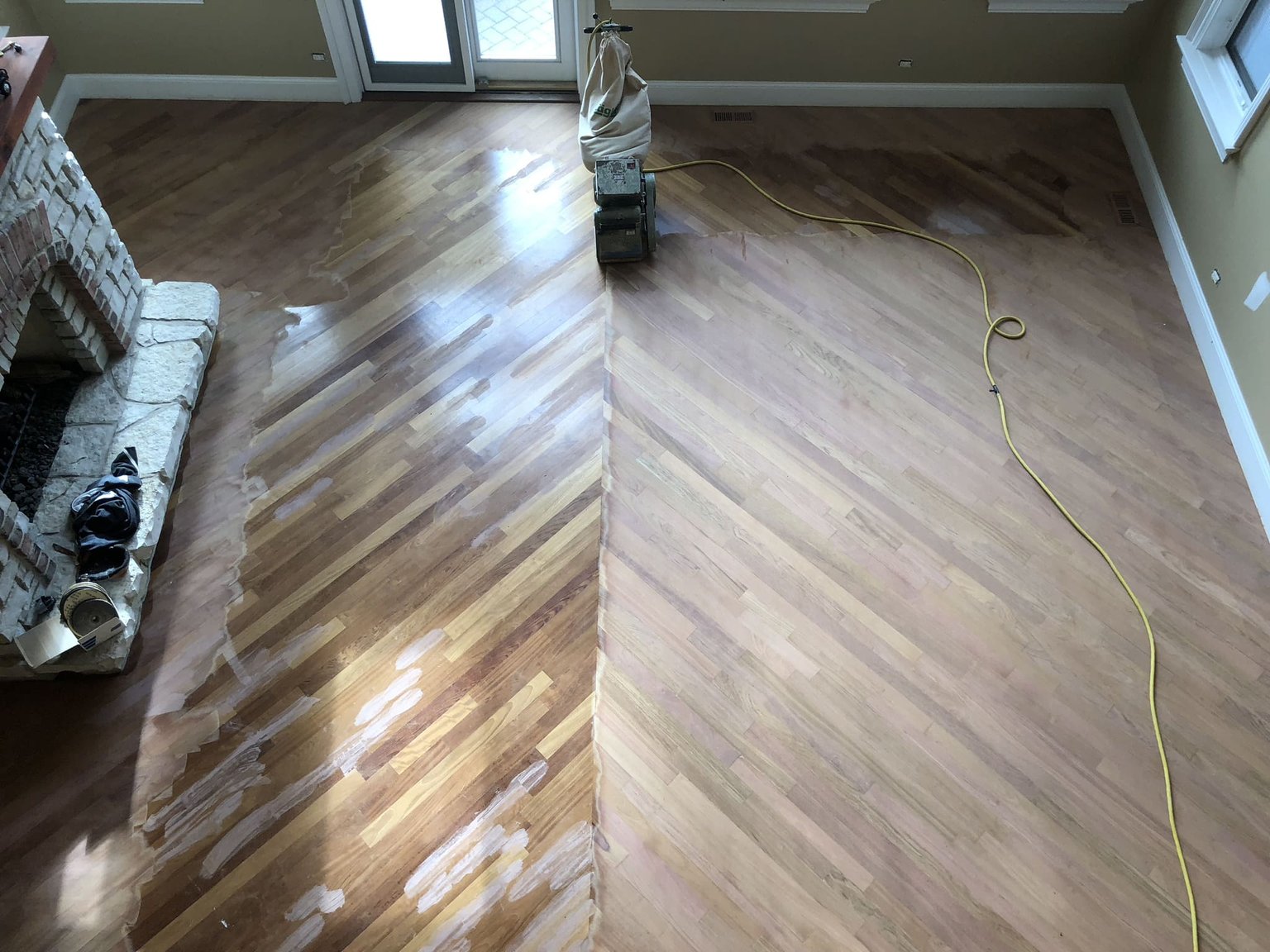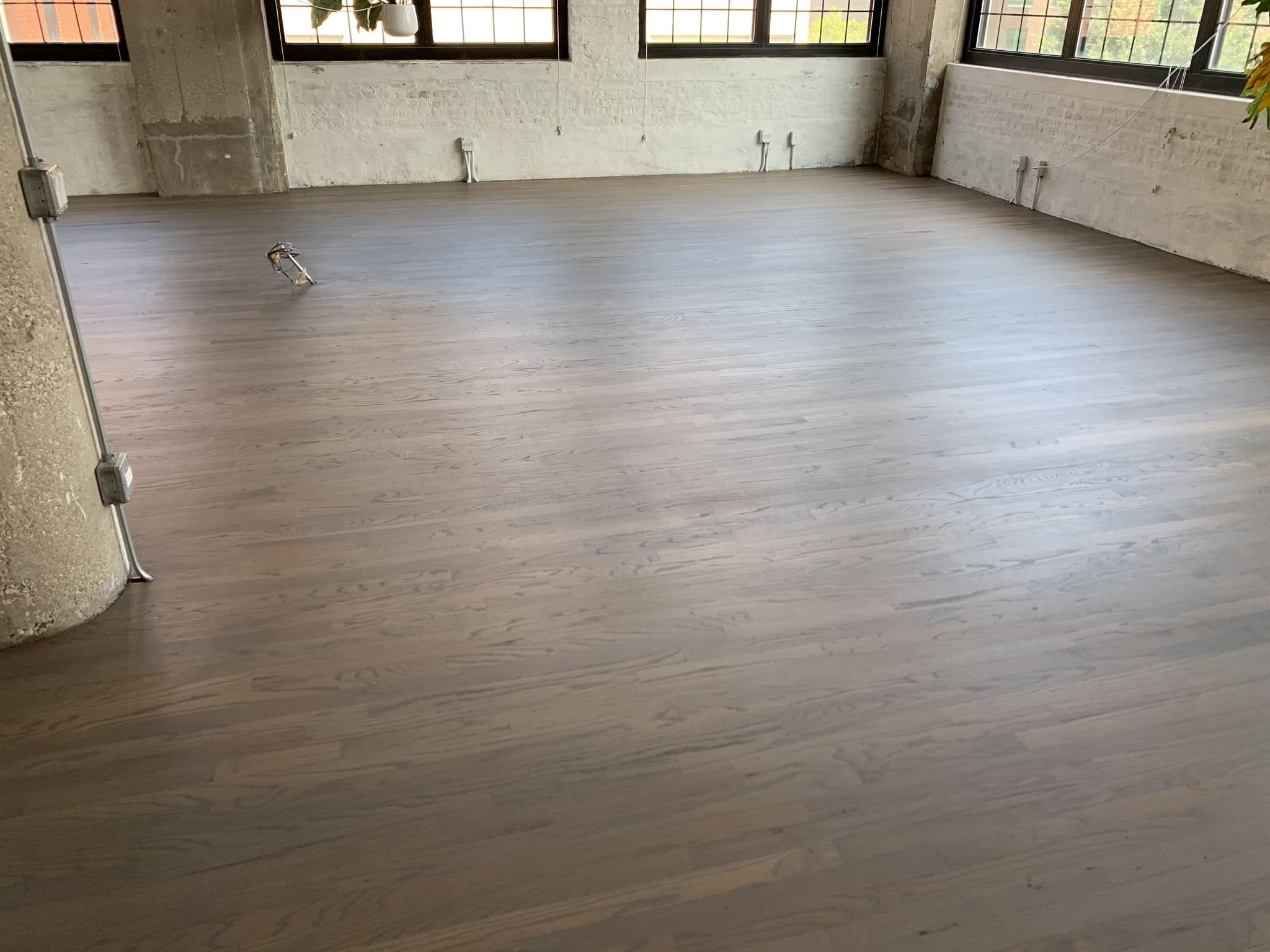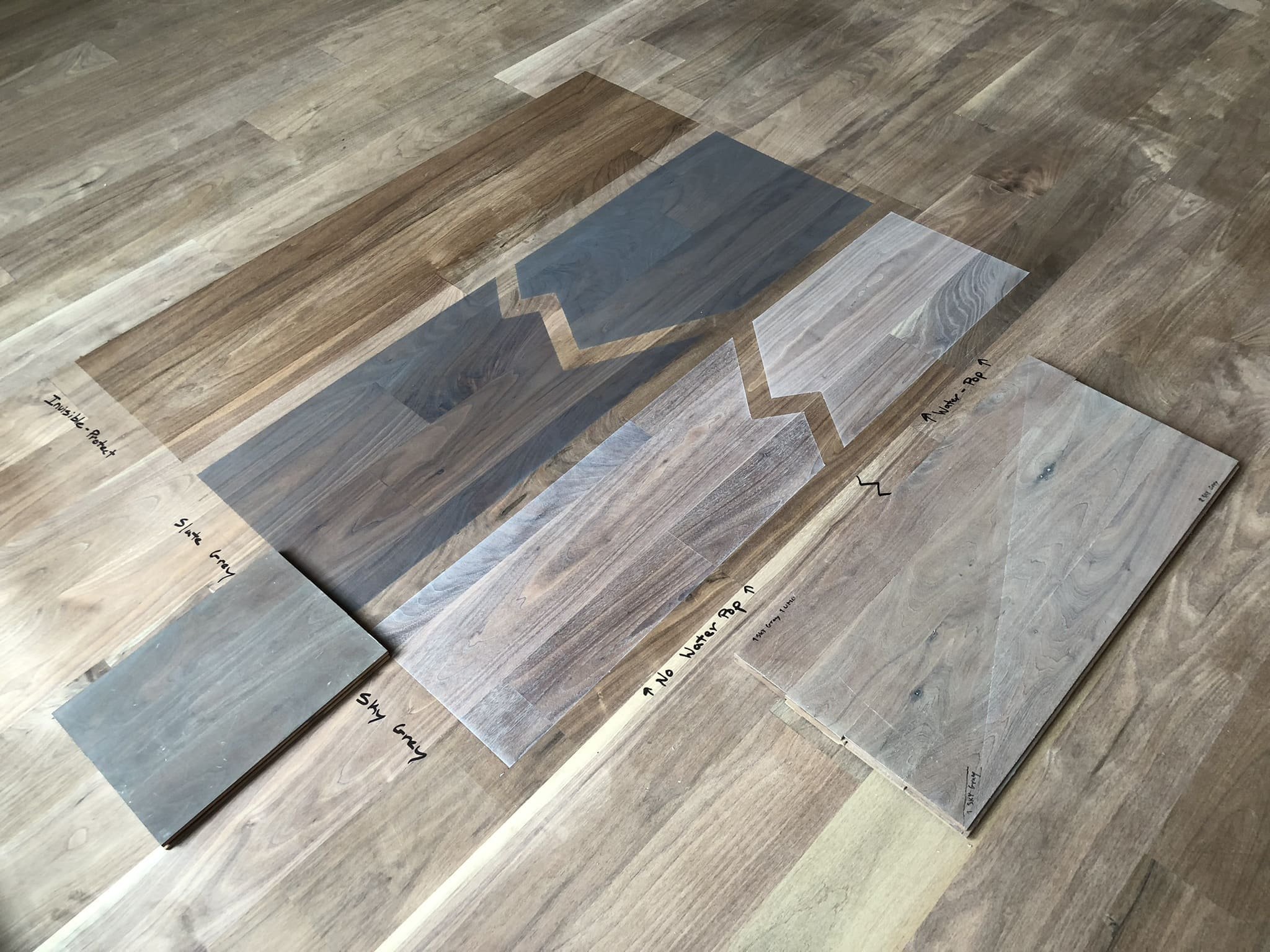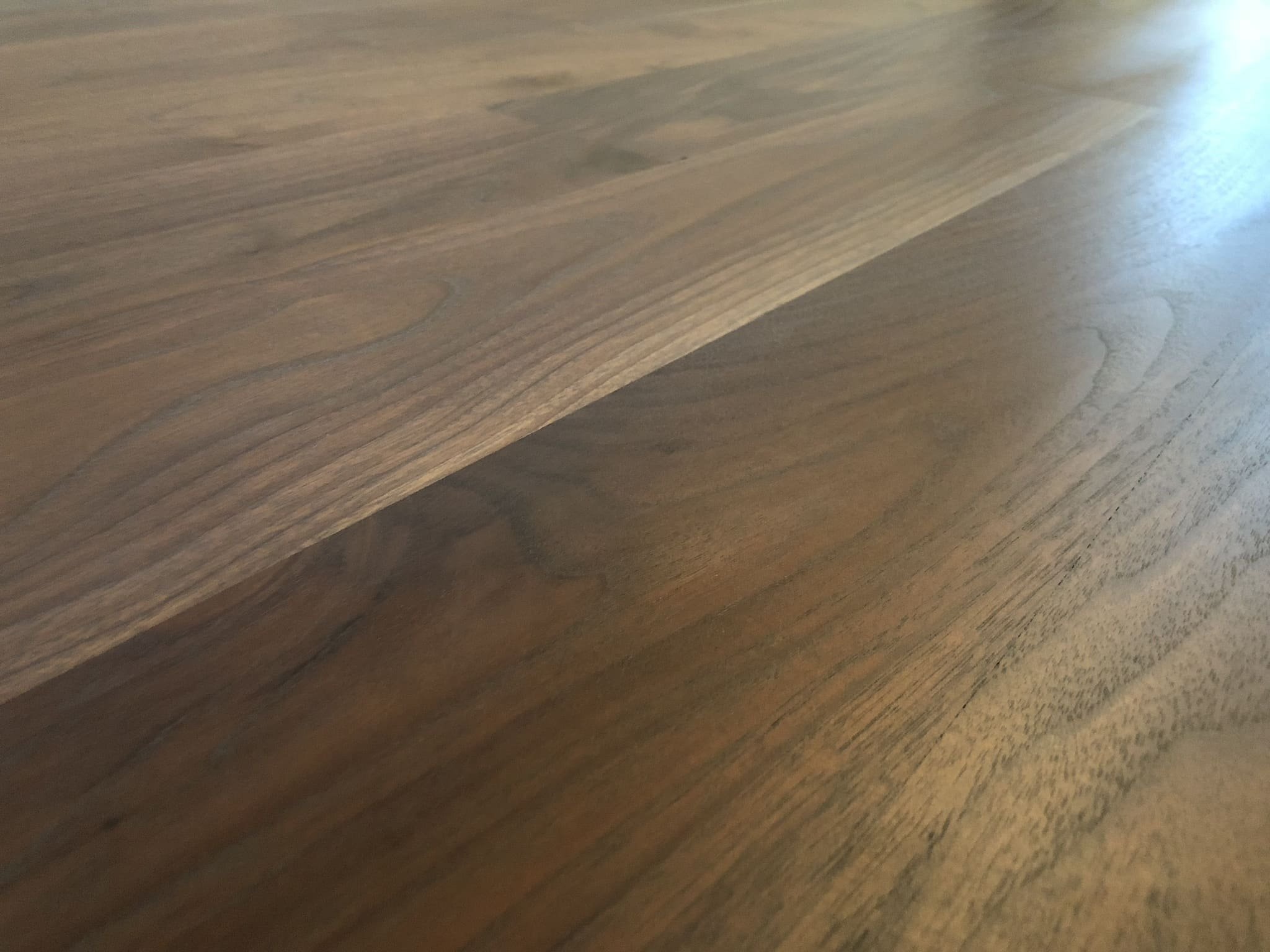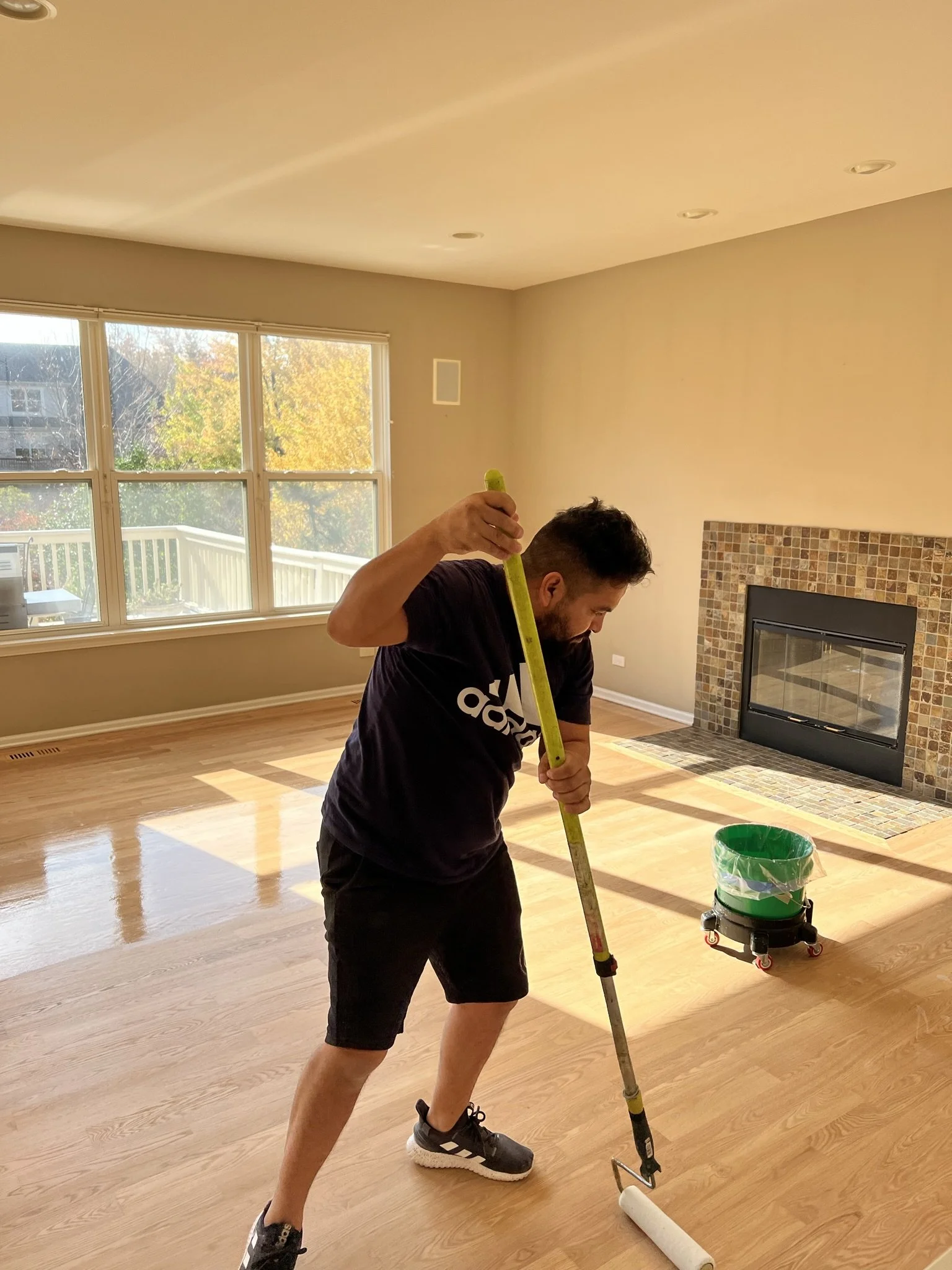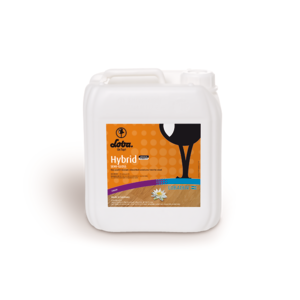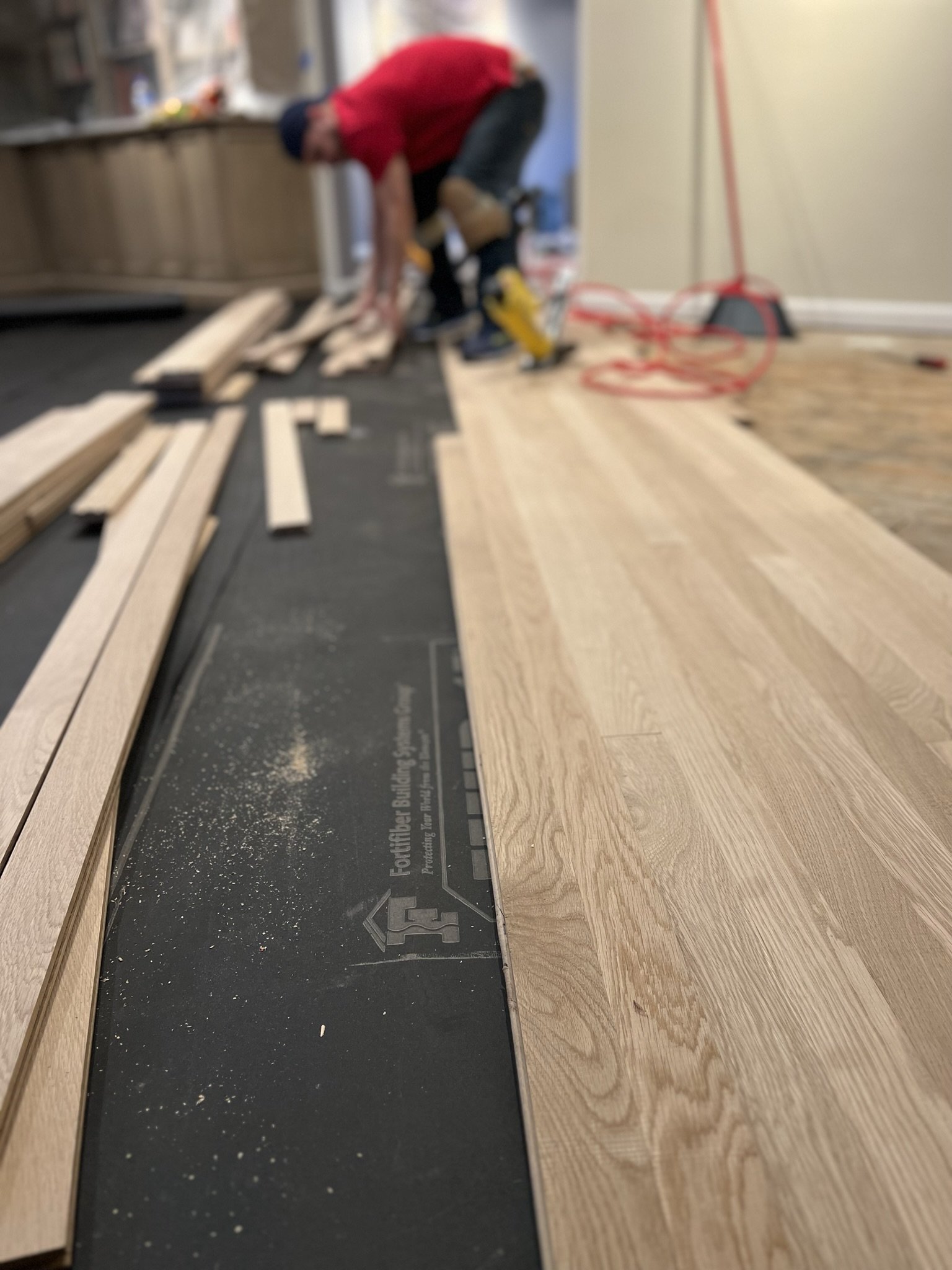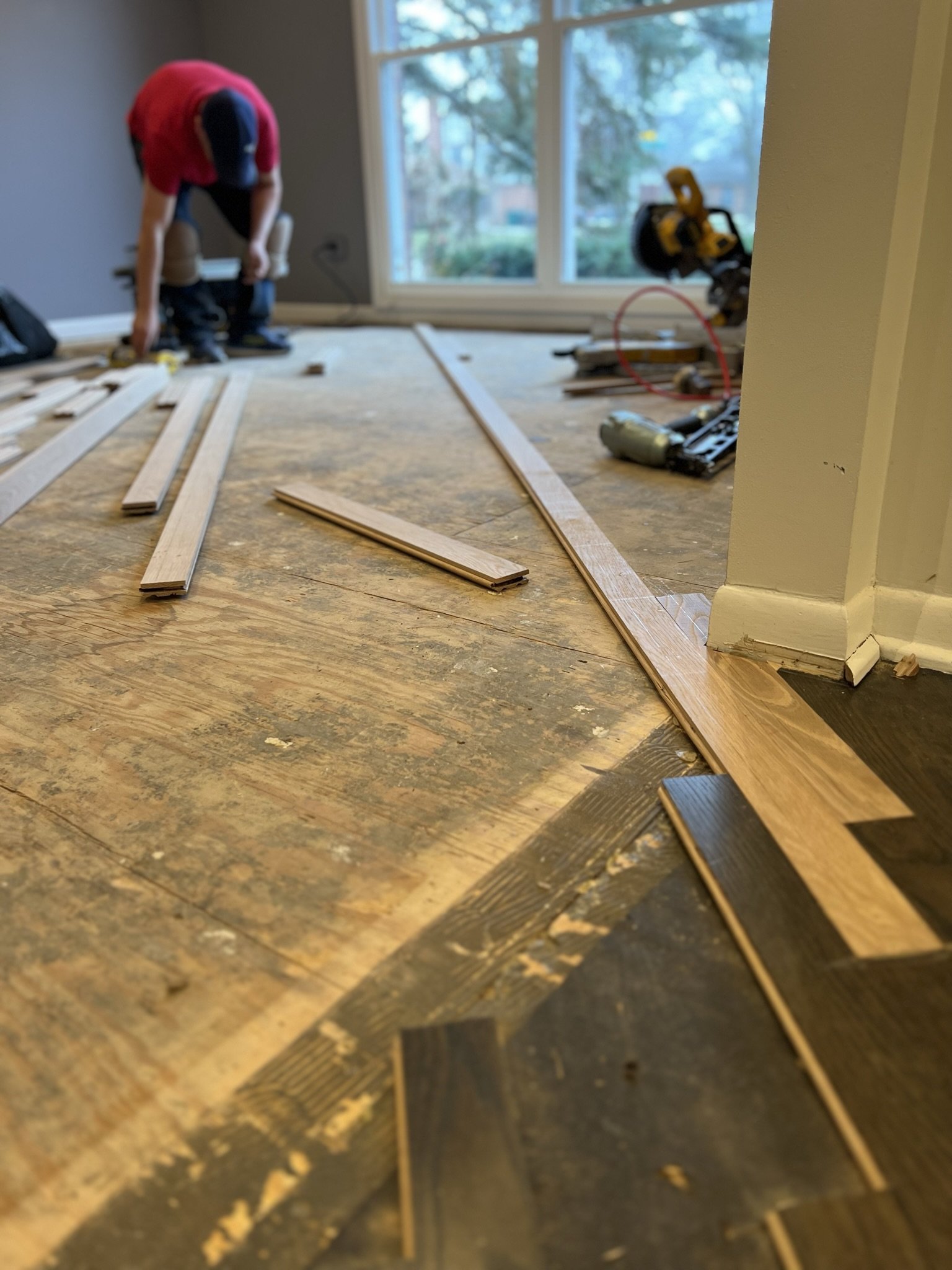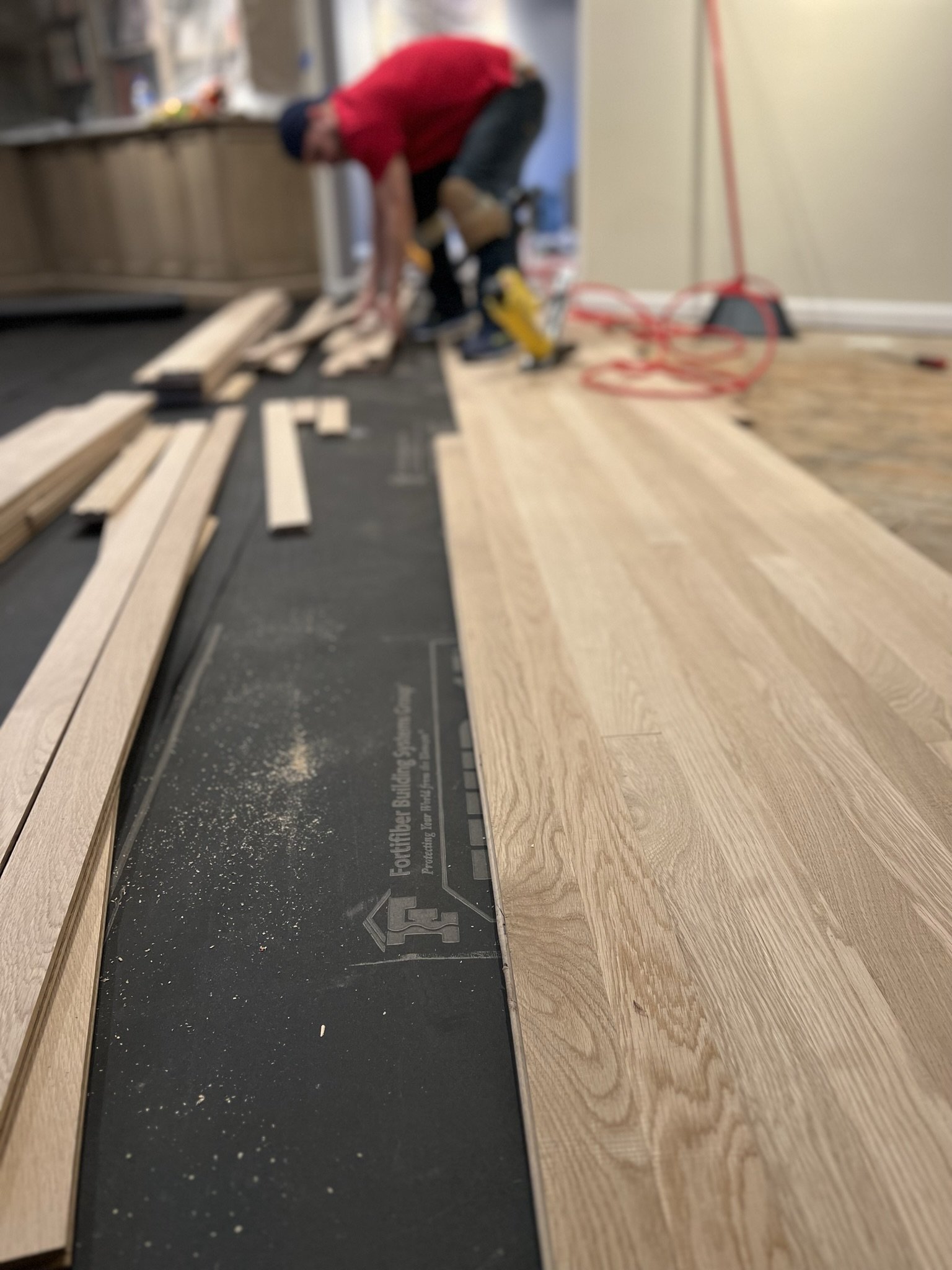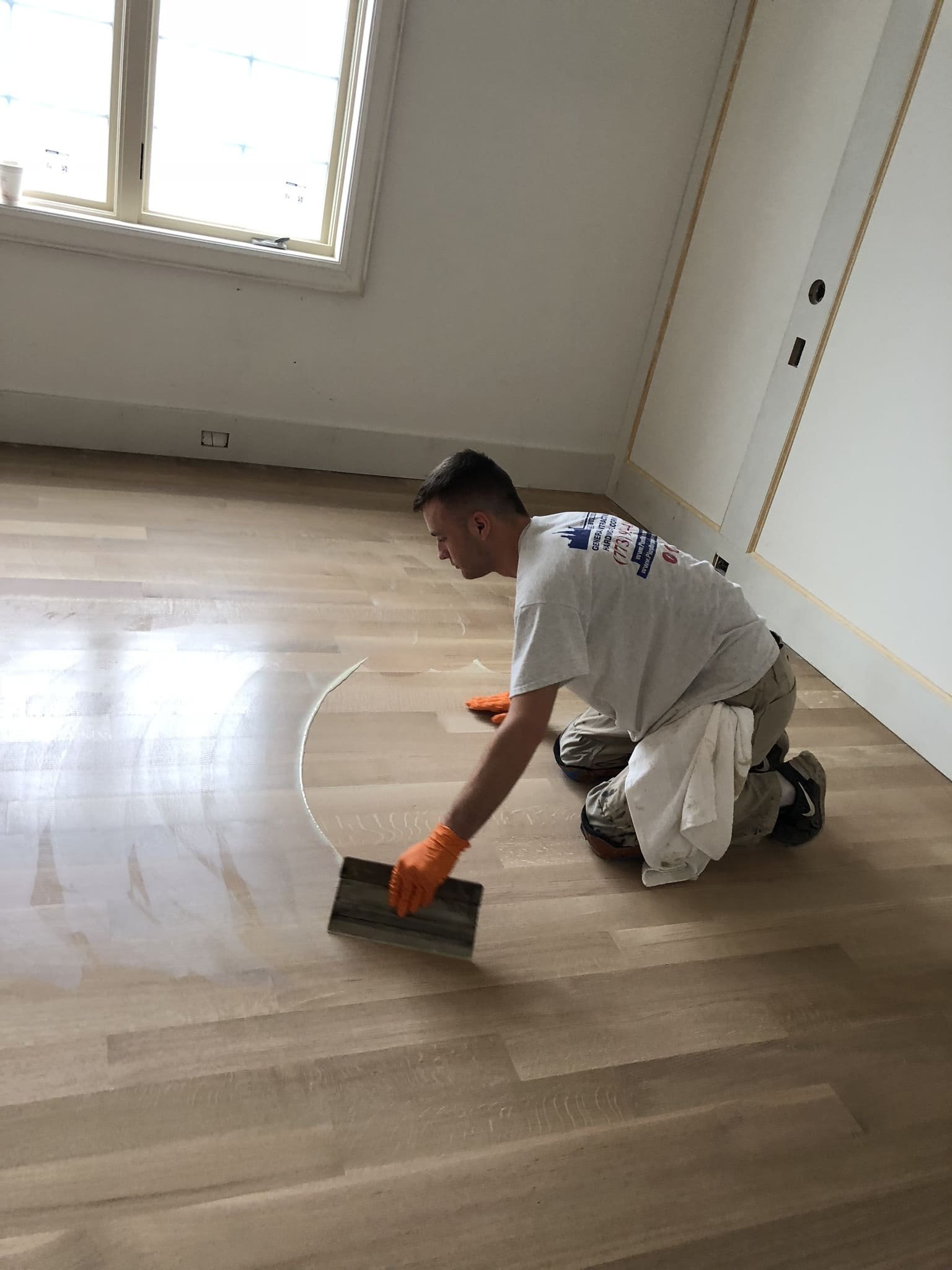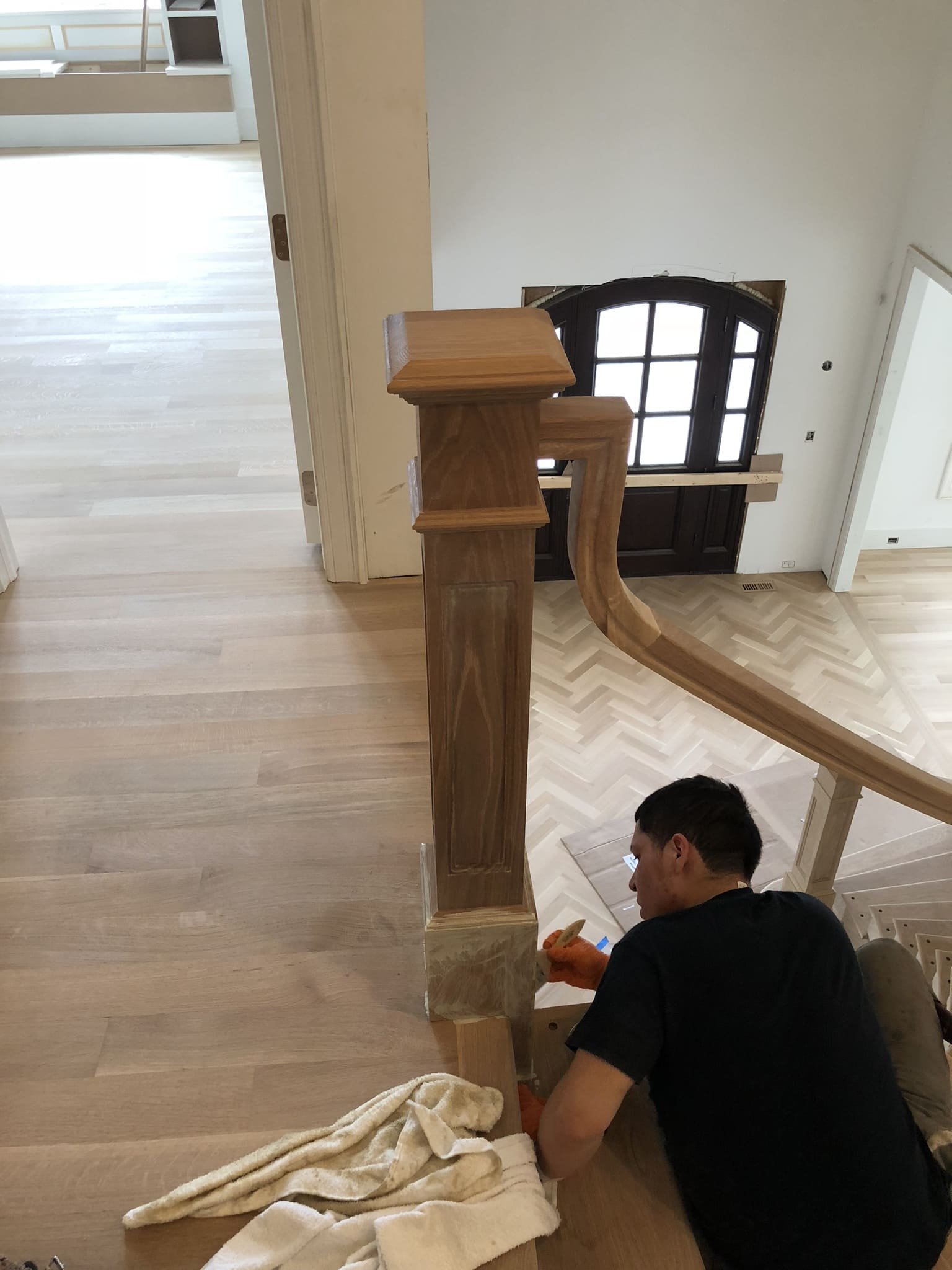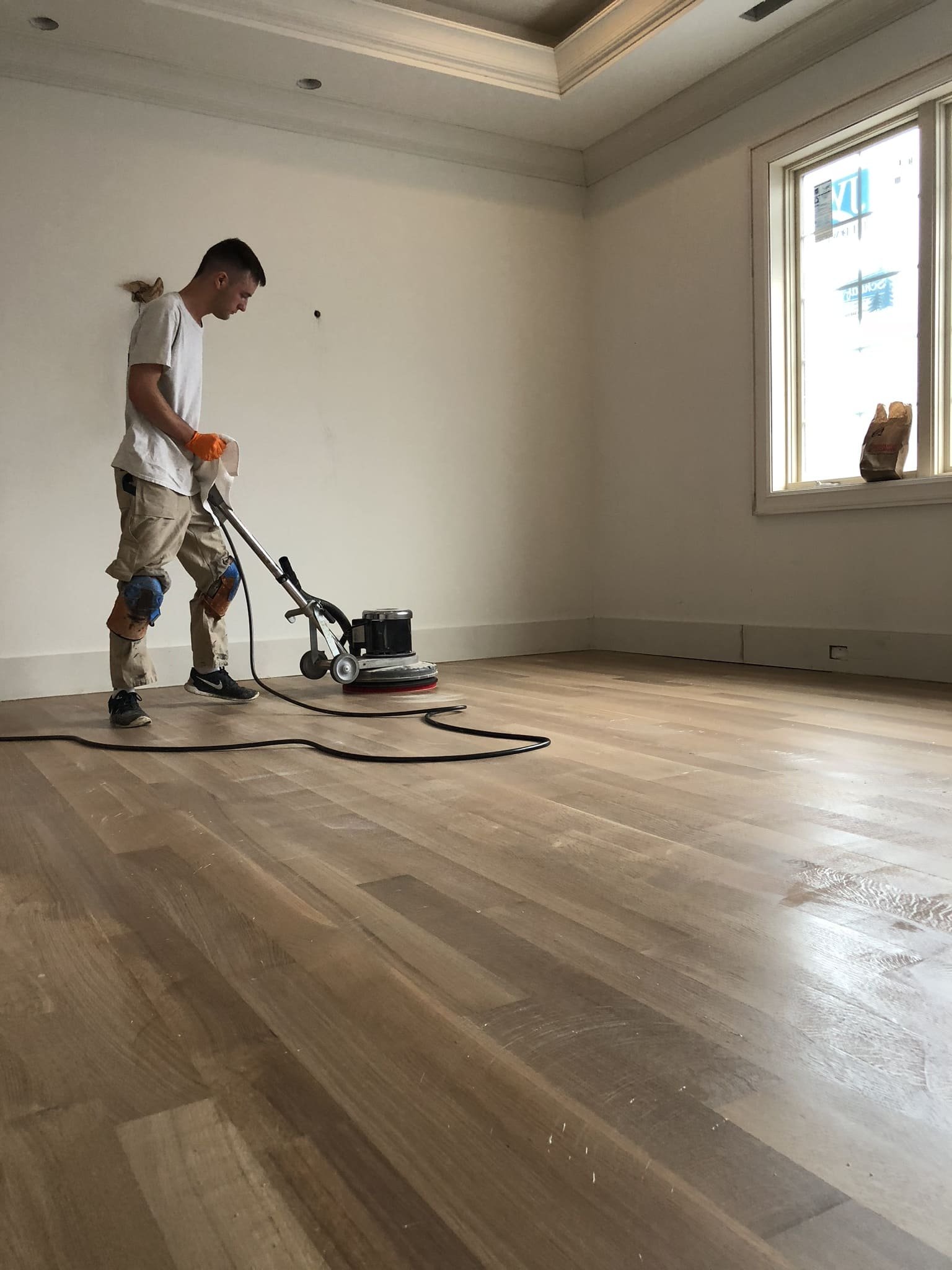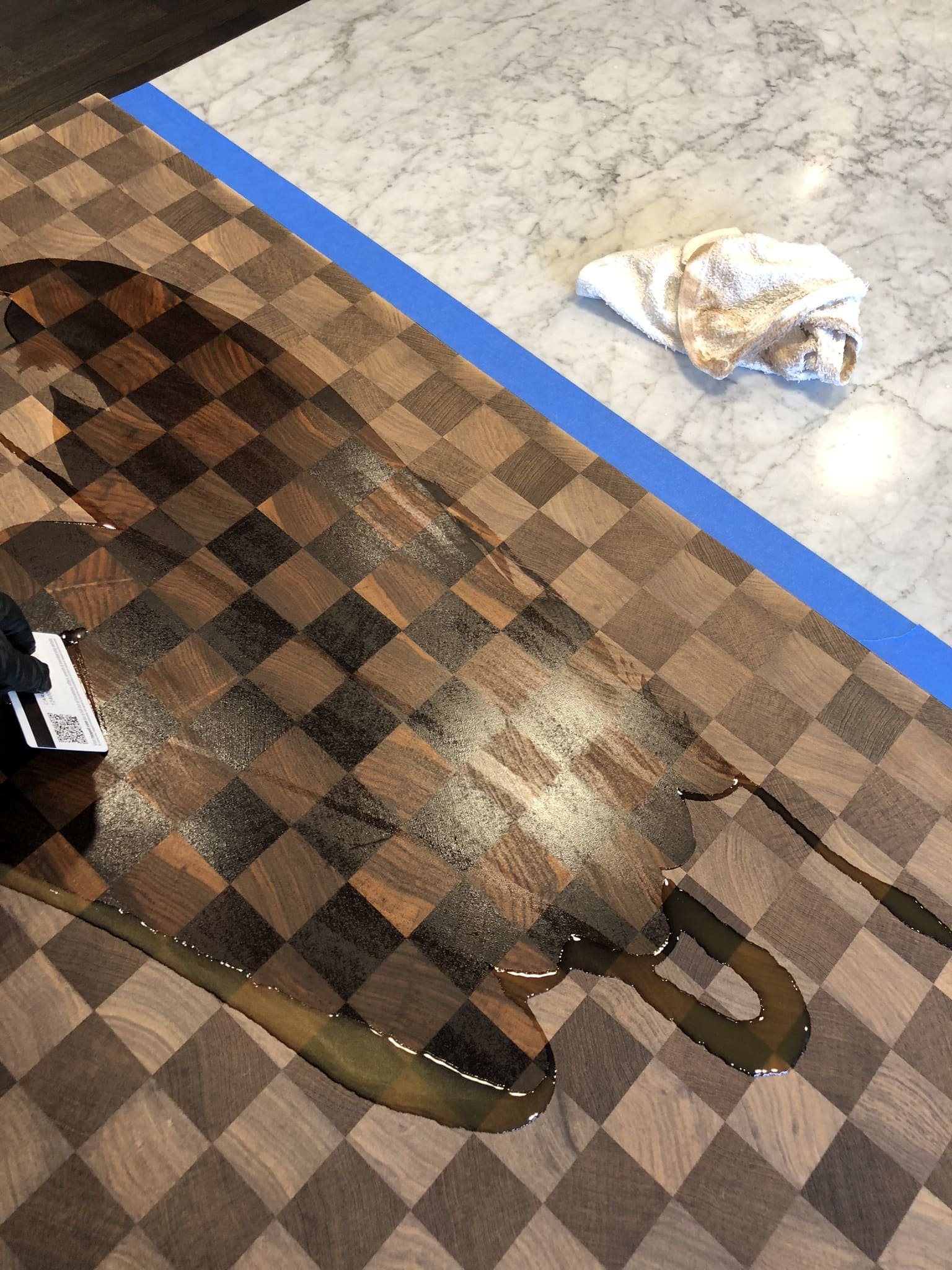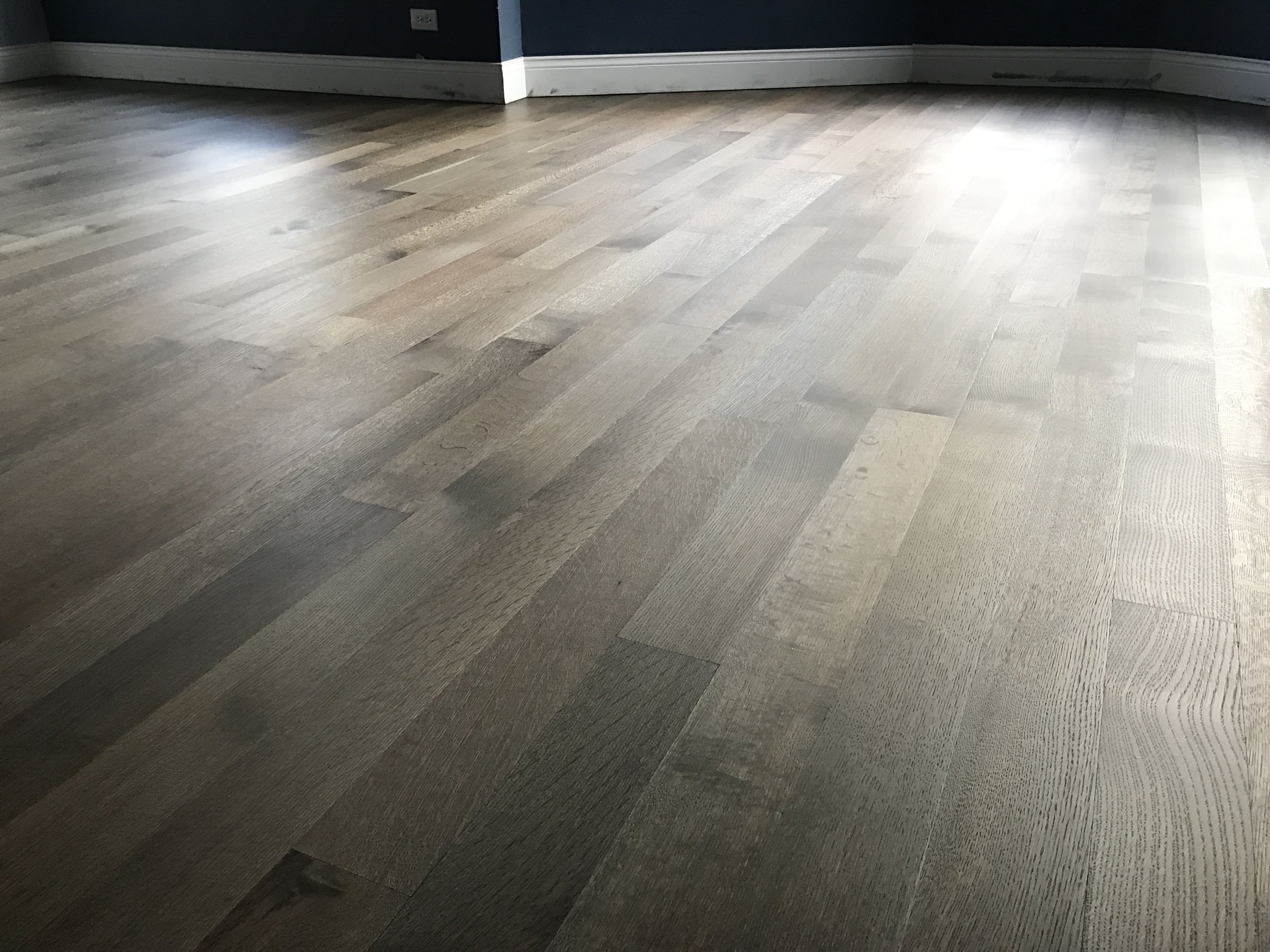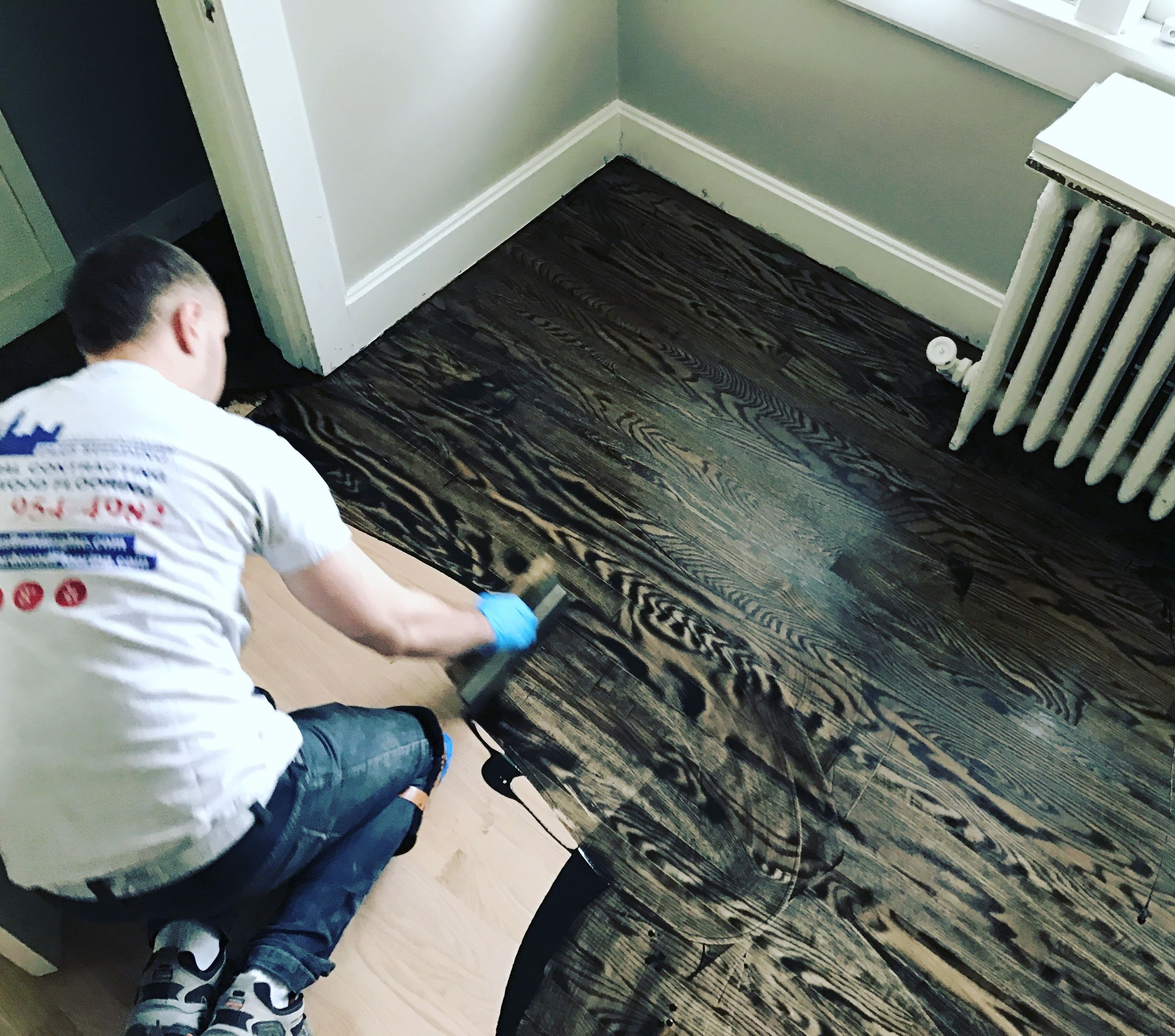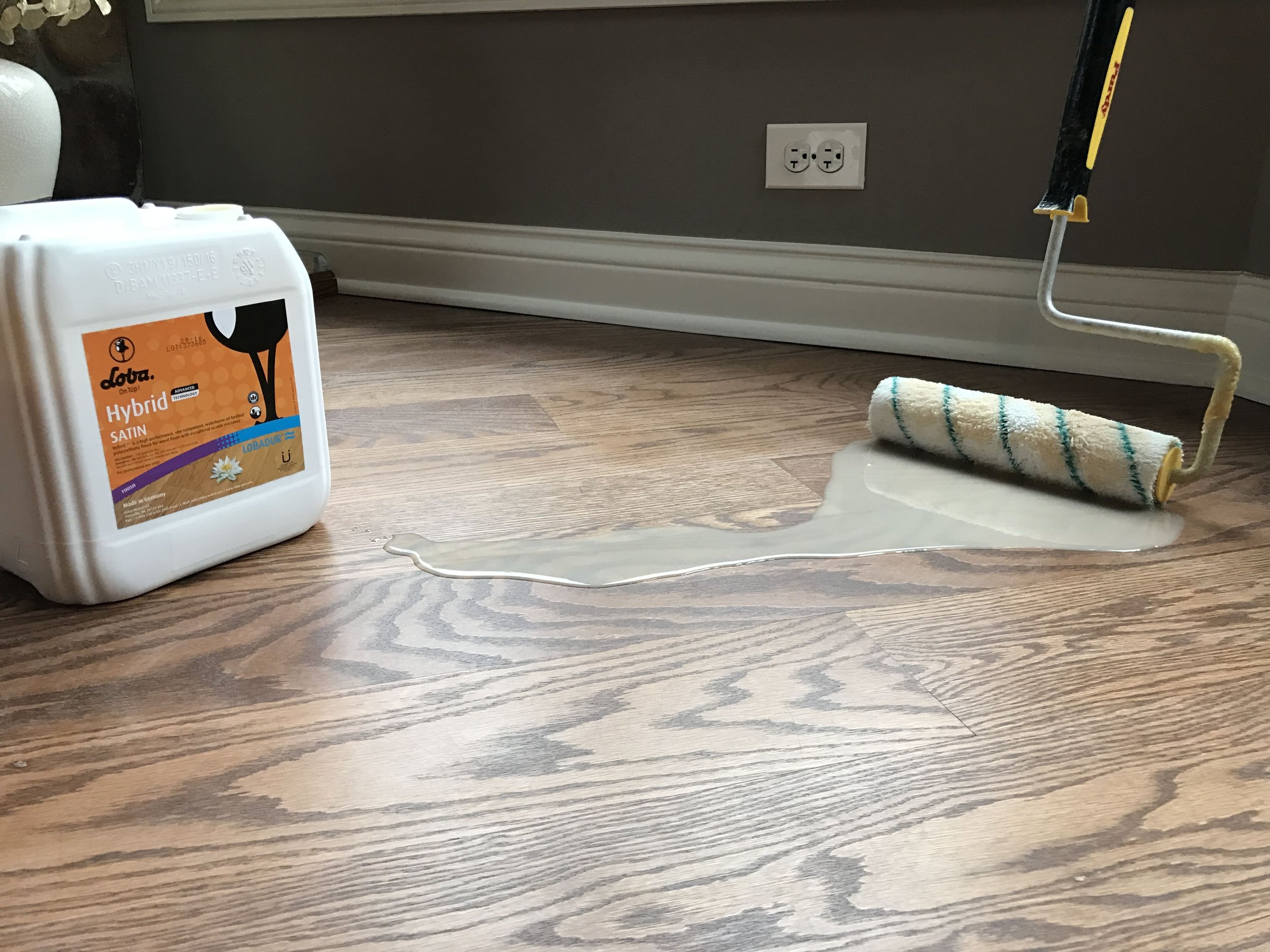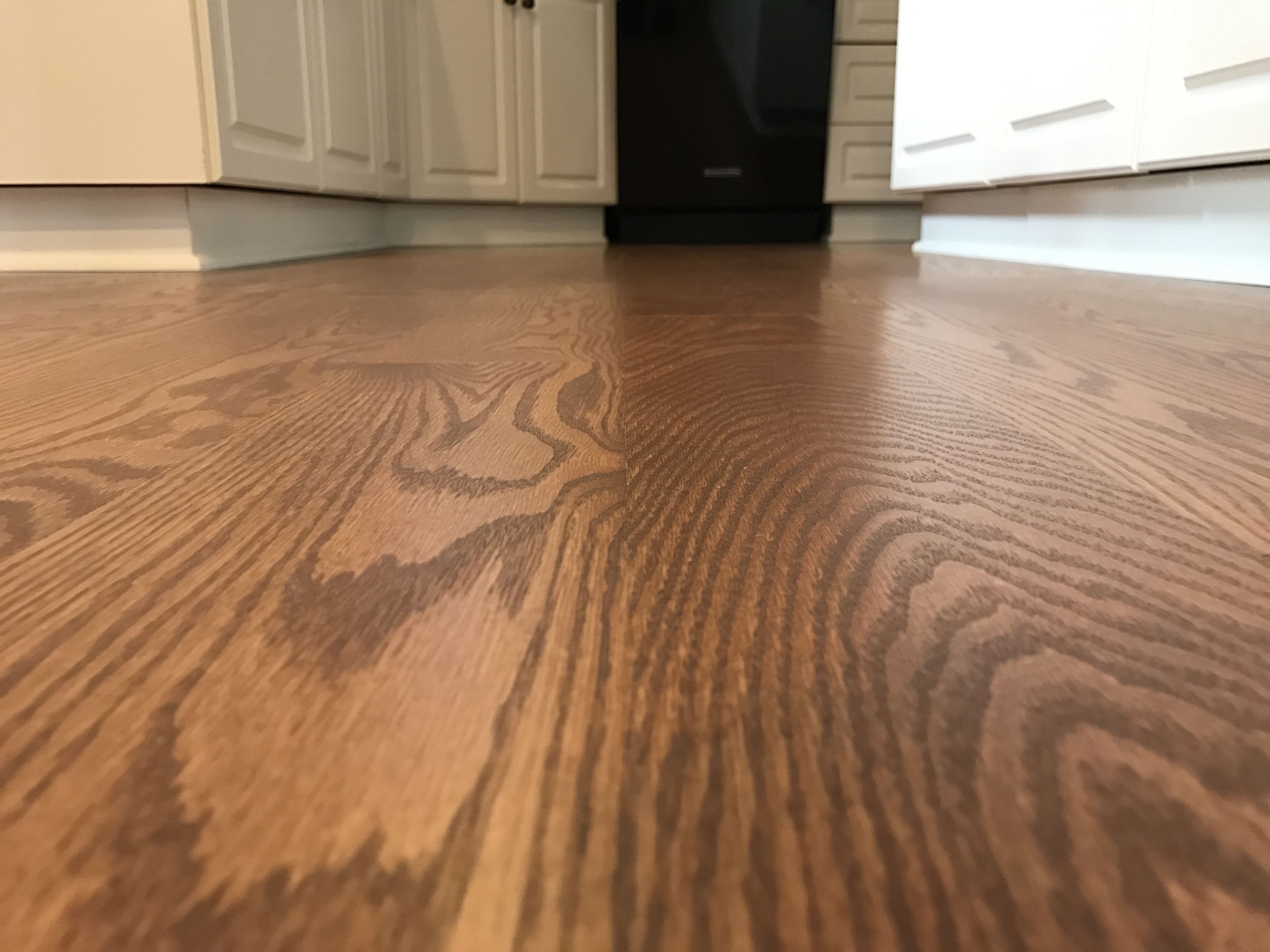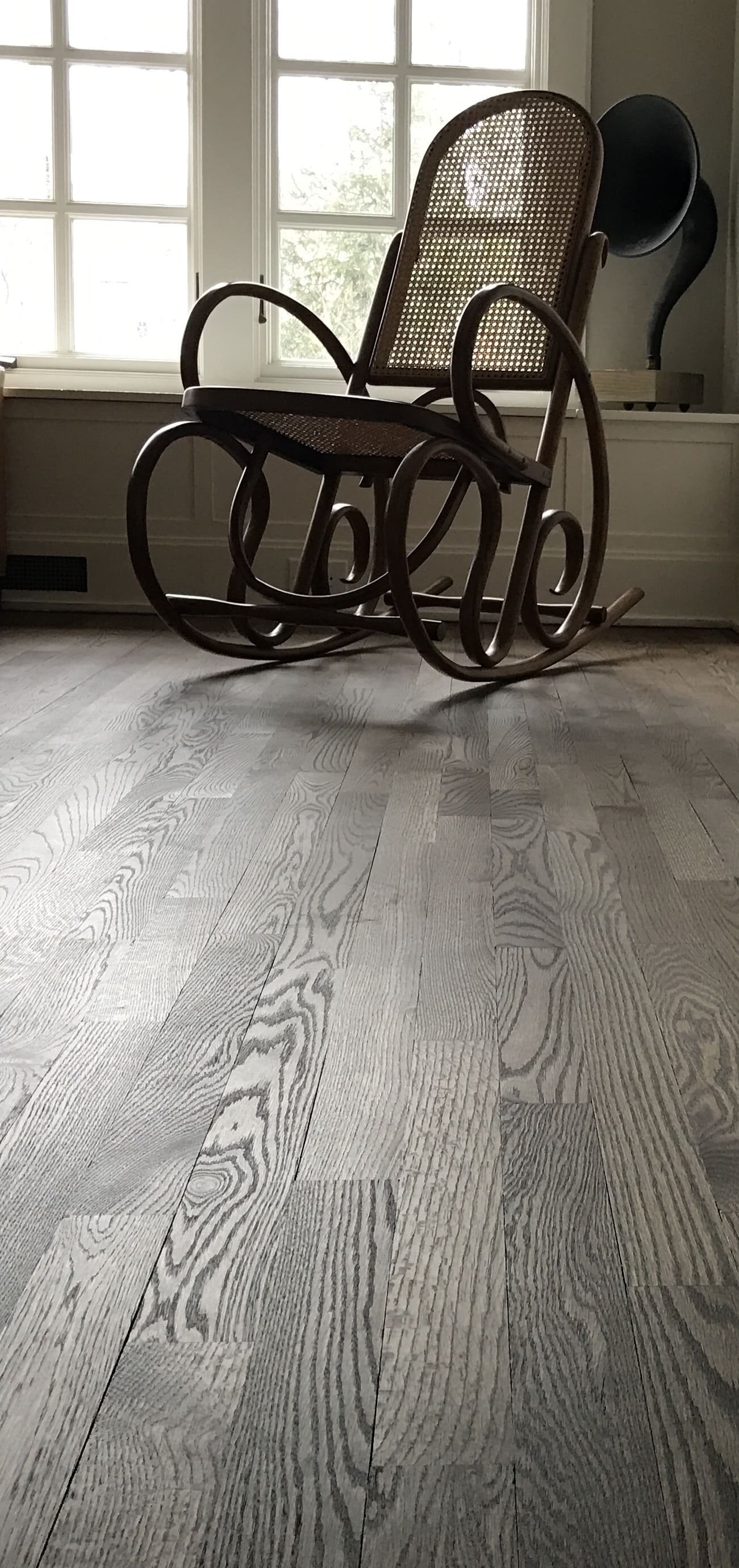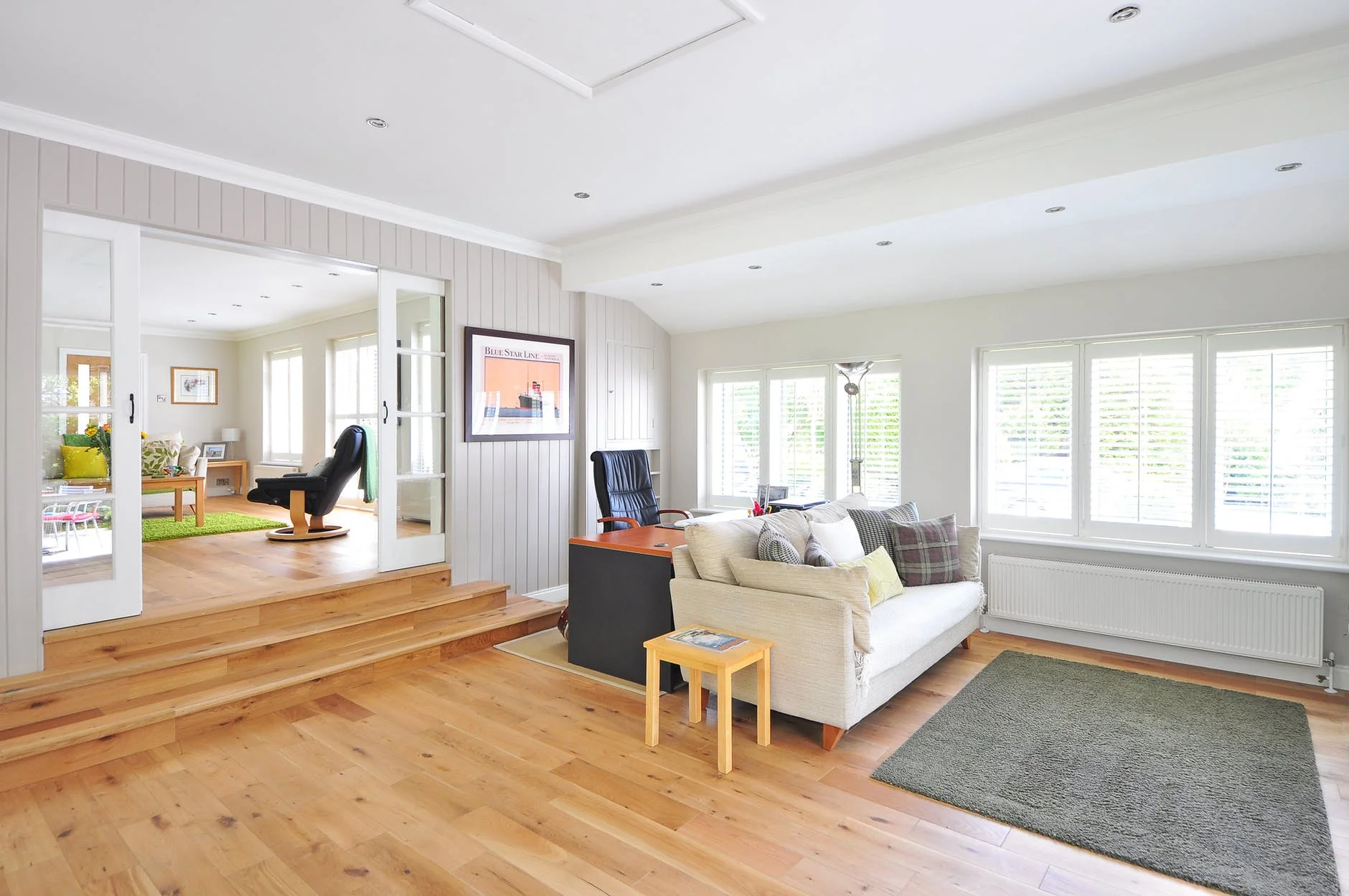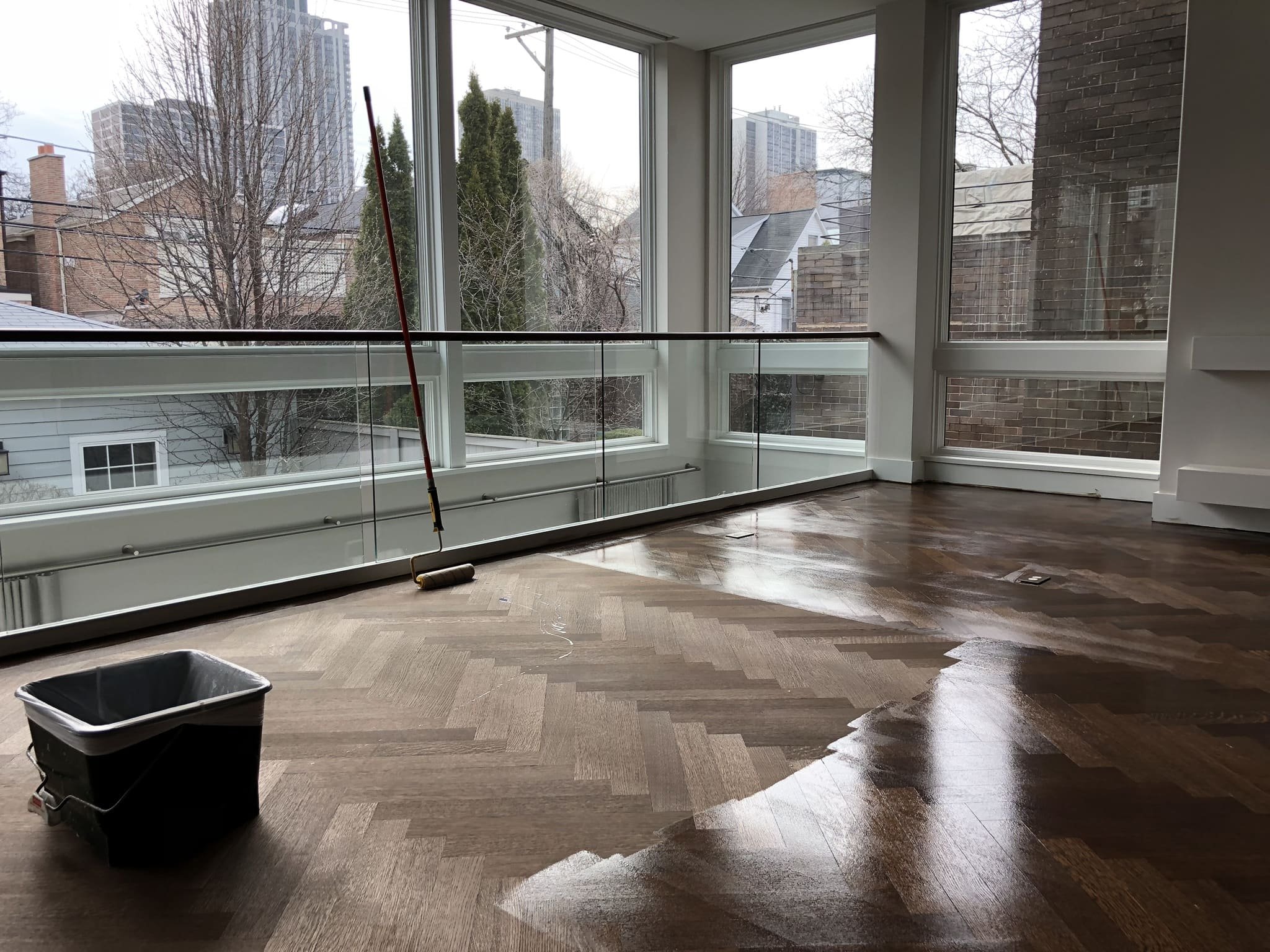
CHICAGO HARDWOOD FLOORING BLOG
Tips and tricks for all your hardwood flooring needs by a local flooring company in Chicago.
Can My Wooden Floor Be Refinished?
Wondering if your floor can be refinished? Join us through the process of revamping hardwood floors, from assessment to rejuvenation. Discover expert tips. Because your floors deserve a second chance to shine!
Hey there, amazing readers! It's Patrick, your friendly hardwood enthusiast, back for another exciting exploration into the world of home transformation. Now, let me set the scene for you – picture this: you stroll into a room, and bam! Your eyes are greeted by the warm, inviting glow of a hardwood floor. That timeless elegance, that classic charm – it's a vibe that's hard to beat.
But, here's the scoop – even the most beautiful things need a little tender loving care to stay on top of their game. Enter stage left: hardwood floor refinishing. It's like a magical makeover for your floors, breathing new life into them, making them look as fresh as the day they were installed, and adding precious years to their lifespan. Exciting, right?
Now, I get it. The world of hardwood floor refinishing might seem like a bit of a maze, especially if you're just getting started. But fret not, my friends! This guide is your personal lantern in the labyrinth, ready to illuminate every step of the way. From figuring out if your floor is refinishing-ready to keeping that newfound radiance alive, we're leaving no stone unturned.
So, are you ready to sprinkle some fairy dust on your hardwood floors and bring back their former glory? Well then, grab your metaphorical toolbelt, because we're about to dive headfirst into the wonderful world of hardwood floor refinishing. Let the adventure begin!
Key Takeaways
Assess your hardwood floor’s potential for refinishing by evaluating its type, wear layer and signs of damage.
Repair any damage before refinishing to avoid Issues. The process involves sanding, staining and finishing.
Regular maintenance is key to extend the lifespan of refinished floors by protecting them from wear and tear.
Assessing Your Hardwood Floor's Refinishing Potential
Removing an old Maple floor that was too damaged for refinishing
Before you even start the task of refinishing a wooden floor, it’s important to first very closely evaluate the condition of your hardwood floors. Are they solid wood or engineered? How worn is the top layer? Are there telltale signs that a refinishing is in order? Answering these questions is key to prevent undertaking a task that may be too challenging, or a task that may not even be possible. Understanding each of these aspects will help you better gauge your floor’s refinishing potential.
First off, I’ll identify the type of hardwood flooring that you have. Knowing your floor type can make all the difference in the world when it comes to refinishing. It’ll also help you better prepare for the project. Next, we’ll measure the wear layer of your floor. A floor with a thick wear layer is a green light for refinishing, while a thin one might necessitate replacement rather than refinishing. Last but not least, I’ll guide you to better recognize the signs that your floor might need a refinish.
Ready? Let’s get started!
The first sanding pass on a very old Brazilian Cherry hardwood floor
Identifying the Type of Hardwood Floor That You Have
Are you aware that your hardwood floor type can have a significant impact on its refinishing capabilities? From oak to acacia, from hickory to walnut, each species of hardwood has its own unique characteristics and refinishing needs.
Solid wood floors like oak or hickory can be refinished multiple times, making them an excellent choice for high-traffic areas. Conversely, engineered wood floors, made of a solid wood veneer on a plywood base, may not hold up as well to refinishing. While their rustic charm and wide planks can be a feast for the eyes, the thin veneer can only withstand a limited number of refinishes. Usually just one or two at most. So make sure you know your proper floor type before you start the refinishing process. Now is also a good time to look into whether you’re going to go with an oil-based finish or a water-based finish as well. Check out some of my other blog posts where I discuss the main differences between the two! You can find all of my other blog posts here.
Measuring the Wear Layer
The wear layer of an engineered wooden floorboard
If the type of hardwood floor is the soul of your refinishing project, then the wear layer is its heartbeat. The wear layer is the top layer of your floor that endures the most from daily activities. Every scratch, every scuff, every piece of furniture dragged across it, all these activities wear down this top layer over time. This top layer is the only part of the floor that can be refinished. Once the wear layer is sanded through, the floor will begin cracking and falling apart.
To determine whether your hardwood floor is a good candidate for refinishing, you’ll need to measure this wear layer. The process is quite straightforward and involves using a drill bit, a pinless meter, and a thermo-hygrometer. A wear layer of at least 3/32 of an inch or 2.5mm is typically necessary for a successful refinishing. Anything less than this, and you might need to consider replacing your floor instead of refinishing it. Most times, you can pretty safely eyeball this wear layer.
Signs You Might Need to Refinish
Now that you’ve identified your floor type and measured the wear layer, it’s time to look for signs that your floor might need a refinish. These signs are like a cry for help from your hardwood floors, signaling that it’s time for some TLC.
The most common signs that your hardwood floors need to be refinished include:
Visible scratches
Dents that are becoming more noticeable or have altered the color of the wood
Fading, particularly in rooms with rugs
Water damage, manifested by spots on the wood or darkened areas
If you notice any of these signs, it might be time for a refinish.
The Lifespan of Hardwood Floors and Refinishing
One of the many beauties of hardwood floors is their impressive lifespan. With the right care, solid wood floors can last a lifetime, or even longer! But like any long-lived entity, your hardwood flooring may need a little pick-me-up every now and then to keep them looking their best.
Refinishing can significantly extend the lifespan of your hardwood floors, but it might not always be the suitable solution. There comes a time when replacement, not refinishing, is the best course of action. But, for most homeowners, a good solid refinishing will fix 99% of the issues on your floors.
When to Say Goodbye
While it’s true that hardwood floors have an impressive lifespan, they’re not immortal, and they’re certainly not concrete. Eventually, the wear and tear of everyday life will take its toll, and your floors will reach the end of their lifespan. Common signs that it’s time for a replacement include mold or rot over the hardwood, extreme wear, and compromised integrity. If you can literally feel the floors giving in below your feet, chances are you can’t refinish them anymore.
When to Refinish
For most homeowners, it will really just come down to the physical appearance of the flooring. If the floors are developing a lot of scratches, or if you are noticing that the top polyurethane layer of the floors is almost no longer existent, then it is certainly time for a refinishing. A telltale sign that the protective layer of your floors is too worn down is when the wooden flooring itself starts to turn black and dirty in color.
Below, is a picture of a floor we recently redid in Chicago. As you can tell on the top left corner, you can see the floors had been so worn down in spots that there wasn’t even any finish remaining! So all of the dirt and grime from walking over the floors was just getting ingrained deeper and deeper into the raw wood of the floors. This causes them to look more and more “dirty”.
A very old floor in the city. Notice the discoloration, black dirt\grime, and all of the scuffs as well as scratches
Same floor, same angle after a full sanding + finishing with Rubio Monocoat Hardwax Oil
Same floor finished with Rubio Monocoat, different angle
Preparing for the Refinishing Process
So, you’ve assessed your hardwood floors and determined that they’re good candidates for refinishing. Great! Now it’s time to roll up your sleeves and prepare for the refinishing process. Before you start sanding, make sure your floors are in the best condition possible.
This might involve fixing any issues like loose boards, gaps, or protruding nail heads. It might also involve a bit of patching to ensure that the refinishing process goes smoothly.
But don’t worry, most of these repairs are simple and can be done with basic tools. For example:
You can tighten loose boards with a few nails
You can fill in deep scratches and big gaps with wood putty
If you encounter any nails sticking out of the floor, you can hammer them down with a nail set. Afterwards, fill the hole with wood filler
The Refinishing Process
The first sanding pass on a hardwood floor with our fancy pants Lagler Trio sander
Now that your floors are in their best shape, it’s time to refinish them. This is a multi-step process that involves sanding, staining, and finishing. Each step is crucial to achieving a beautiful and durable finish. I’ve got plenty of blog posts that can guide you through this process step by step.
Don’t be intimidated by the process. With the right tools and a bit of patience, you can breathe new life into your floors. Here are the general refinishing process steps.
Sanding Your Floors
Sanding the edges of a hardwood floor before the next Lagler Trio sanding pass
Sanding is the first step in the refinishing process and perhaps the most important one. It involves removing the old finish and smoothing out any imperfections on your floors. This step is crucial in preparing your floors for the new finish.
To sand your floors, you’ll need a drum or belt sander, a dust mask, and a bit of elbow grease. Start with a coarse grit sandpaper to remove the old finish and gradually move on to finer grits for a smooth finish. Remember to always sand in the direction of the wood grain to avoid scratches and uneven surfaces.
Staining and Choosing Finishes
After sanding your floors, you can start adding color. Staining your floors can enhance the natural beauty of the wood and give your floors a fresh new look. Plus, it allows you to customize the look of your floors to match your home’s decor.
When choosing a stain for your floors, consider the type of wood and the overall look you’re going for. Light stains can bring out the natural grain of the wood, while dark stains can add a touch of elegance and sophistication. Once you’ve chosen a stain, it’s time to apply a finish to protect your floors and keep them looking great for years to come.
Cost Considerations for Refinishing Hardwood Floors
Applying stain with a floor buffer
Refinishing your hardwood floors is a worthwhile investment. Not only does it enhance the look of your floors, but it also increases their lifespan. However, like any home improvement project, it comes with many challenges and a cost. From hiring a professional to doing it yourself, the cost of refinishing your hardwood floors can vary based on several factors.
So, how much is the expected cost of refinishing your hardwood floors? And is it more cost-effective to do it yourself or hire a professional? I’ll try to quickly touch on these questions as I close out this blog post.
DIY vs. Professional Refinishing
If you’re handy and have some time to spare, you might consider refinishing your floors yourself. DIY refinishing can save you a pretty penny, but it does require a significant amount of time and effort. Plus, you’ll need to rent or buy the necessary equipment, which, if not planned properly, can end up costing you more then just hiring someone to do it.
Hiring a professional to refinish your floors can save you time and ensure a high-quality finish. However, professional services come with a higher price tag, typically ranging from $5 to $10 per square foot around our area. Weigh the pros and cons of each option to decide which is the best fit for your budget and schedule.
Maintaining Your Refinished Hardwood Floors
Freshly finished hardwood floors with Rubio Monocoat 2c Pure
After refinishing your hardwood floors, it’s important to maintain their appearance. Regular maintenance can extend the lifespan of your floors and prevent the need for another refinishing down the line.
Proper maintenance involves more than just regular cleaning. It also means protecting your floors from everyday wear and tear. Let’s examine some methods to maintain the look of your refinished floors.
Protecting Against Wear and Tear
Take the following steps to protect and maintain your hardwood floors:
Place felt pads under your furniture to prevent scratches
Avoid wearing shoes or heels in the house to minimize dirt, dents, and grime
Use products specifically designed for hardwood floors when cleaning
Stay away from any cleaning products claiming to “shine up” your floors
With these safety measures in place, you can enjoy the newly refinished hardwood floors in your home for many years to come.
Summary
Revitalizing your hardwood floors is truly a rewarding adventure, one that can infuse a whole new energy into your living space. I've had a blast being your guide on this journey, sharing insights from assessing your floors’ refinishing potential to preserving their newfound radiance. Think of it as a roadmap to a home transformation, crafted just for you!
Now, I understand that diving into the refinishing world might seem like stepping into the unknown, but fear not, because armed with the right knowledge and a dash of enthusiasm, you're fully equipped to restore your floors to their magnificent best. Picture it – the warmth, the glow, the sheer timeless elegance that your hardwood floors are about to exude!
Ready to embark on this exciting venture? Why not kickstart your refinishing journey today? Your floors are eagerly awaiting the magic touch that only you can provide. And hey, if you find yourself in need of a little extra guidance or want to explore professional flooring services, don’t hesitate to swing by our website. There, you’ll discover a treasure trove of tips, and on our contact page, you're just a message away from turning your hardwood dreams into reality. Here's to a future filled with the enduring beauty of your newly refreshed floors. Happy refinishing, friends! 🌟
Frequently Asked Questions
When can wood floors not be refinished?
Wood floors cannot be refinished if they are more than 150 years old, have extreme movement between boards, or have substantial structural problems that require the flooring to be removed and the subfloor fixed. In these cases, a replacement is necessary.
Is it cheaper to refinish floors or replace?
Refinishing your hardwood floors is almost always more cost effective than replacing them due to the additional costs associated with wood, installation, and labor.
Can damaged wood floors be refinished?
Yes, damaged wood floors can typically be refinished if the damage is minor enough. Floors with cracks, scratches, discoloration, mild warping, and gaps can all be repaired through sanding, refinishing, patching, etc.
What type of wood is best for flooring?
Oak flooring is the most popular choice for wood flooring due to its durability, color range and reasonable cost. Other good options include maple, cherry, bamboo, walnut, ash and mahogany, with more exotic species such as teak, jarrah and mesquite available at a higher cost.
How often should I refinish my hardwood floors?
It is recommended to assess the wear layer of your hardwood floor every 15 to 20 years in order to determine when refinishing is necessary.
What is the Best Finish for Walnut Floors? Your Complete Guide
Are you interested in the proper finishes and finishing procedures for Walnut hardwood flooring? In this blog post we include all recommended finishes, waiting times, and safety tips + best practices for your Walnut hardwood floors.
Hey guys, Patrick here! Today is all about Walnut flooring. Walnut floors are undoubtedly a stunning addition to any home, but how do you ensure they stay that way for years to come? The secret lies in choosing the perfect finish. With the right finish, you’ll protect your floors and enhance their natural beauty, ensuring that they remain a focal point of your home. If you aren’t sure about what kind of wooden floors you have in your home, or what kind of wooden floors you want in your home, check out my other blog post which will help you narrow it down!
From understanding the unique characteristics of walnut floors to exploring various types of finishes, we’ll guide you through the most important factors to consider and even provide our top recommendation for the best finish. Are you ready to unlock the secret to gorgeous, long-lasting walnut floors? Let’s go!
The first sanding pass on a walnut hardwood floor
Key Takeaways
Proper finishing is key to protecting your walnut floors, with oil-based polyurethane offering enhanced graining/knotting but higher VOC levels compared to water-based finishes.
We recommend Loba Water Based Finish due to its durability, scratch resistance & low VOCs, hire us or follow the correct application process yourself.
If you’re just here looking for the product, then here is an Amazon link to the best Loba water based finish that I recommend. If you are more interested in going with the less expensive oil-based alternative, here is a link to that one.
Understanding Walnut Floors
Walnut is a sought-after wood for flooring, known for its rich color and unique wood grain. But not all walnut floors are created equal. There are two main types of walnut flooring available: Brazilian and American Walnut, each with their distinct properties and benefits.
Finishing your walnut floors is a pivotal step in safeguarding them from daily wear and tear, including scratches, stains, and moisture damage. A properly applied finish can also enhance the natural beauty of walnut, showcasing its unique grain patterns and color variations. Let’s examine Brazilian and American Walnut in greater detail and understand the significance of selecting the right finish.
Brazilian Walnut vs. American Walnut
Brazilian Walnut, also known as Ipe wood, boasts impressive durability and longevity. With a Janka hardness rating of 3690, it is highly resistant to wear and damage, making it an excellent choice for flooring applications. On the other hand, American Walnut, often referred to as Black Walnut, has a lower Janka hardness rating of around 1010, meaning it’s softer and more prone to wear and damage compared to its Brazilian counterpart. Both types of walnut will require proper finishing to ensure their protection and longevity.
While Brazilian Walnut is denser and more durable, American Walnut offers a wider range of colors, from creamy white to dark brown, and is known for its stability and good shock resistance. Irrespective of the type of walnut flooring you opt for, selecting a suitable finish that enhances the wood’s natural attributes and provides sufficient protection against daily wear and tear is necessary.
Rubiomonocoat samples and finishes on an American Walnut floor
The Importance of Proper Finishing
A proper finish is the key to preserving the beauty and durability of your walnut floors. It not only protects the wood from damage but also enhances its aesthetics by bringing out the natural color and grain. A good finish also makes cleaning and maintenance easier, as it prevents dirt and spills from penetrating the wood surface.
There are various types of hardwood floor finish available, each with its own advantages and disadvantages. Some popular finishes for walnut floors include:
Oil-based polyurethane
Water-based polyurethane
Rubio Monocoat Wax
Other natural finishes
Evaluating the advantages and disadvantages of each type of finish coat, including their sheen levels, is necessary to determine which one will meet your needs and preferences best.
Types of Hardwood Floor Finishes
Oil-based and water-based polyurethane dominate as the most popular choices for residential hardwood floor finishes. Understanding the distinct advantages and disadvantages of each finish type is key before making a decision.
To aid your decision-making, let’s examine the primary types of hardwood floor finishes: oil-based polyurethane, water-based polyurethane, rubio monocoat hard wax oil.
Oil-Based Polyurethane
One quart of Duraseal oil based poly
Oil-based polyurethane is a popular finish made from drying oils like linseed oil, soya oil, or tung oil, combined with a resin. This type of finish provides a warm, amber hue and is known for its durability. However, it has a longer curing time, typically around 30 days, and emits higher levels of volatile organic compounds (VOCs) compared to water-based polyurethane. For a finish like this, it is never recommended to stay inside of your home when it is applied or drying.
Despite its longer curing time and higher VOC levels, oil-based polyurethane can provide a beautiful, durable finish for your walnut floors. It enhances the natural graining and knotting in hardwood planks and offers excellent scratch protection and elasticity. But it might be more susceptible to yellowing over time than water-based finishes, so consider these factors when deciding on what the best finish will be for your specific living situation.
Water-Based Polyurethane
Loba Invisible 2K Water-based Finish
Ah yes, my absolute favorite, Water-based polyurethane. It is an eco-friendly alternative to oil-based finishes an it offers several advantages:
It dries VERY quickly
It has low VOC levels
It forms a strong bond with the wood, making it resistant to scratches, stains, and fading
It provides a clear, natural look that complements walnut floors beautifully
It does not have the yellowing effect of oil-based polyurethane
Although water-based polyurethane may cost more than oil-based polyurethane, it comes with several benefits, such as quicker drying & curing time (around 5 hours) and reduced VOC levels. In my personal opinion this finish not only looks better than the other options, but it also performs much better. If you have a home with pets and children, or you need to be back in your home asap, this is definitely one of the best options available. The choice between oil-based and water-based polyurethane will ultimately depend on your individual needs and preferences.
Rubio Monocoat Hardwax and Other Natural Finishes
Rubio Monocoat Hardwax Oil Finish
Rubio Monocoat and other natural finishes, such as shellac and wax, offer a low-sheen, natural look for your walnut floors. They can enhance the wood’s natural appearance but may not be as durable as oil-based or water-based polyurethane finishes. Over the years, I’ve applied a ton of this finish to floors.
These finishes typically require more work to apply and more maintenance. With Rubio Monocoat, you will need to have it re-waxed and re-applied every three to six years. These are very high end designer finishes and they are going to be by far your most expensive option. The re-application process works a lot like a buff & recoat, the floors will NOT need to be sanded back down to raw wood for a maintenance rewaxing.
While these finishes may not offer the same level of durability to spills and chemicals as a water based finish, they tend to have better scratch resistance because of the low sheen layer. If you have the budget for this option, I actually highly recommend it. The colors that Rubio Monocoat has are unmatched by any other manufacturer in our industry. Also, in my professional opinion, the way the floors physically look when they are finished with Rubio is incredibly unique, and truly stunning.
Factors to Consider When Choosing a Finish
Rubio Monocoat samples on a walnut floor
Selecting the best finish for your walnut floors involves considering factors like durability, aesthetics, and environmental impact. Each finish type comes with its unique set of advantages and disadvantages as we went over, so careful consideration of your options is necessary to choose the finish that fits your needs and lifestyle best.
Consider the purpose of the room, the amount of foot traffic the floor will endure, and your personal preferences for the floor’s appearance. For most customers, I think it mainly boils down to the extra pricing of these finishes as the final deciding factor. Assessing all of these options can aid you in making a sound decision about the best finish for you.
Durability and Maintenance
When choosing a finish for your hardwood floors, durability is a key consideration. A durable finish will protect your floors from:
Everyday wear and tear
Scratches
Stains
Discoloration
However, it is also important to note that wooden floors are not tile or concrete. They can not withstand as much traffic or force as stone can. I always tell my clients to have realistic expectations when it comes to wear and tear on your floors.
Maintenance also plays a significant role. Different finishes may require varying levels of care and upkeep, so it’s critical to choose a finish that aligns with your lifestyle and cleaning habits. For instance, oil-based and water-based polyurethane finishes are sturdy and low-maintenance, while wax finishes might require more upkeep to maintain their appearance. Opt for a finish that provides an optimal balance of durability and maintenance for your requirements.
Aesthetics and Wood Grain Enhancement
The finish you choose can also have a significant impact on the appearance of your walnut floors. Different finishes can bring out different features of the walnut, such as enhancing the warm hues or giving the wood a glossy shine.
Think about how the finish will accentuate the wood grain and improve the overall aesthetics of your walnut floors. You may prefer a clear finish that highlights the natural beauty of the wood, or a warm, amber hue that enhances the wood’s depth and richness. By taking aesthetics into account, you can ensure that your chosen finish will enhance the overall look and feel of your walnut floors.
Lately, the trend has been very matte floors. Most customers don’t even want to look at samples of shiny finishes anymore. And I whole heartedly agree with them. The lower the sheen of the finish that you choose, the more beautiful the flooring project will turn out, in my opinion.
Walnut floor finished with Loba Invisible
Environmental Impact and VOCs
Considering the environmental impact and the levels of volatile organic compounds (VOCs) in the finish is also important when making a decision like this. VOCs are carbon-containing chemicals that evaporate easily at room temperature and can affect indoor air quality.
Oil-based polyurethane finishes generally contain higher VOC levels than water-based finishes, potentially leading to increased indoor air pollution and potential health risks. Consider the VOC content and the possible environmental impact of the finish on your home and the environment when choosing a finish. Additionally, using mineral spirits for cleaning up oil-based finishes is a common practice.
Our Recommendation: Loba Water-Based Finish or Rubio monocoat
Based on my knowledge and experience, I highly suggest either the Loba water-based finish or Rubio Monocoat for your walnut floors. Loba’s 2K InvisibleProtect is an excellent choice for its durability, scratch resistance, and protection against wear and tear. However, Rubio Monocoat is also an excellent choice for it’s very unique looks and special colors. Both finishes do a great job of protecting the natural beauty of the wood while still offering excellent protection from scratches. The Loba will give you more chemical resistance to spills, however the Rubio will give you better scratch protection but will require more maintenance later down the road.
Both of these options also have low VOC levels, marking them as an eco-friendly choice. With their numerous advantages and suitability for walnut floors, it is tough to choose the better finish out of these two. But if I had to choose, for most clients, the Loba water-based finish would be my top recommendation for the best finish to use, not just on your walnut floors, but on any hardwood floors.
Application Process and Tips
Adhering to the correct application process and tips will ensure a successful and long-lasting finish using Loba water-based finish. Begin by sanding the floor to prepare the surface for the finish.
Before applying the finish, ensure that the temperature and humidity are within the ideal range, with a temperature of 68°F (20°C) and a humidity level of 45-55%. Always make sure to use a roller that is acceptable for water-based finish. It must be microfiber, these are the ones we usually use. Wait at least 24-48 hours after applying the finish before placing furniture on the floors to ensure that the finish is fully cured.
Applying the final coat of Loba water based finish
Hiring Flooring Professionals
While you can apply a finish to your walnut floors yourself, hiring a flooring professional can guarantee optimal results for your project. Flooring professionals have the experience, knowledge, and tools necessary to properly install and finish your walnut floors, helping you avoid potential mistakes and ensuring a beautiful, long-lasting result.
When choosing a flooring professional, it is important to:
Do research
Check social media for pictures of their work
Check credentials and licenses
Review contracts and invoices
Undertaking due diligence can help you ensure that you’re collaborating with a competent and reputable contractor who can help you attain the best outcome for your walnut floors.
Questions to Ask Your Contractor
Before engaging a contractor, inquire about their experience, the products they use, and their suggestions for your particular flooring needs. Inquire about their equipment, and ask to see a portfolio of their past projects. Additionally, verify that they are licensed and insured to perform the type of work required for your project.
Asking pertinent questions and collecting information about your potential contractor can help you make a well-informed decision about whom to hire for your floor finishing project.
DIY vs. Hiring a Professional
When deciding whether to handle your walnut floor finishing project yourself or to hire a professional, consider the advantages and disadvantages of each option. DIY can save you money and provide a sense of accomplishment but may also result in accidental damage to the hardwood or a less-than-professional finish. On the other hand, hiring a professional can ensure better results, quicker and more efficient work, and increased home value, but may come at a higher cost.
Take into account factors like your experience, skill level, and the complexity of the project. Keep in mind you will need to rent very specialized equipment in order to do this properly. Walnut, even for professionals, tends to be a very difficult wood to sand correctly. Ultimately, the decision between DIY and hiring a professional will depend on your individual needs, preferences, and budget.
Caring for Your Walnut Floors
Appropriate care and maintenance are key to maintaining the beauty and longevity of your walnut floors. Frequent cleaning and maintenance not only maintain your floors’ appearance but also protect them from dirt and debris that can scratch and erode the floor finish.
Setting up a regular cleaning routine and implementing preventive measures, like using protective pads on furniture and avoiding too much moisture, will help ensure that your walnut floors continue to enhance your home’s beauty for years.
Cleaning Routine
To preserve the beauty and durability of your walnut floors, implement a regular cleaning routine that involves:
Daily sweeping or dusting to eliminate dirt and debris
Spot cleaning spills immediately to prevent stains and damage
Vacuuming every few days to remove additional dirt and dust
Using a damp mop with a soft terry cloth head or a special cleaning mop designed for hardwood floors when needed
Utilizing mild cleaning solutions, like Bona Hardwood Floor Cleaner or a homemade mix of white vinegar and water, can help maintain your floors’ appearance without causing harm. By following a consistent cleaning routine, you’ll protect your walnut floors and ensure they stay looking their best for years to come. If you want to dive a little deeper into the cleaning process and have more questions, check back into my blog in a month as I’ll have a new, very detailed, blog post about it.
Preventing Damage
Besides regular cleaning, you can take several steps to safeguard your walnut floors from damage. Position protective pads or glides under furniture to shield the floors from scuffs and scratches, and (for the love of God) please refrain from dancing or walking in stilettos & high-heeled shoes which can cause dents.
Be mindful of moisture, as excessive moisture can cause damage to walnut floors, such as warping, buckling, or swelling. Place walk-off mats at entrances to help minimize the amount of abrasive dirt and debris that can be brought in onto the floor. By taking these precautions, you can help preserve the beauty and longevity of your walnut floors.
Concluding Thoughts
In conclusion, choosing the perfect finish for your walnut floors is essential for protecting them and enhancing their natural beauty. By understanding the unique characteristics of walnut floors, exploring various types of finishes, and considering factors such as durability, aesthetics, and environmental impact, you can make an informed decision about the best finish for your needs.
With my recommendation of Loba water-based finish and the guidance provided in this blog post, you’re now equipped to choose the ideal finish for your walnut floors! I hope this info helped shine some light on all the different types of finishes that are available for not just Walnut floors, but all hardwood floors.
I hope you enjoyed reading my blog post. I’ve been doing my very best to get new blog posts for you guys and I’ve got a whole heck of a lot more coming. Stay tuned. And as always, reach out to us if you need your floors done!
Up close of a walnut floor fully finished with Rubio Monocoat
Frequently Asked Questions
What is the best Stain for walnut flooring?
Oil-based stains are the best choice for black walnut flooring due to their deep pigments; use a brush, cloth or rag to apply it following the grain of the wood. Wipe it dry once applied.
Should I stain walnut floors?
If you like the natural look of walnut, it's best not to stain it. The colors and texture will stand out well on their own, creating a classic wood look.
How do you make walnut floors shine?
Restore your walnut floor's natural shine by having a simple Buffing & Recoating process completed on the floors. Apply a new coat of finish and the sheen level of the floors will entirely be restored.
What is the difference between Brazilian and American Walnut flooring?
Brazilian Walnut is denser and more durable with a higher Janka hardness rating, while American Walnut offers a wider range of colors and better shock resistance.
Which type of finish is more durable, oil-based or water-based polyurethane?
Water-based polyurethane is generally considered more durable than oil-based polyurethane, as it is better able to withstand dents and other damage. Previously, this used to be reversed. But the water-based products have seen exponential improvement in our industry.
Can You Sleep in a House After Hardwood Floor Polyurethane Application?
It's important to be aware of the safety concerns when it comes to sleeping in a house after hardwood floor polyurethane application. Find out recommended waiting times and safety tips.
Hey guys, Patrick here again! This week the main topic I wanted to talk about on our Chicago Flooring Blog was a question I often receive from homeowners. “Can I sleep in my house after you apply the polyurethane?” as well as “How soon can I move back in after you apply the final finish coat to my hardwood floors?”
By this point, we all know that one of the key steps in installing & refinishing hardwood flooring is applying a finish, such as polyurethane, to protect the wood and give it a smooth appearance. However, many homeowners may wonder whether it is safe to sleep in their homes after a polyurethane application.
In this blog post, we'll explore the answer to that question and provide detailed information on how long you should stay out of the house after a polyurethane application, depending on the type of finish used.
Applying the first coat of water based finish
Types of Finishes for hardwood flooring
First, it's important to understand that polyurethane is a type of varnish that is applied to hardwood floors to protect them from wear and tear. However, it is not only available in both oil-based and water-based forms, but there are also other products that exist which do the same job as polyurethane.
The main difference between these products is that some are oil-based, which have a strong odor and take longer to dry and cure. Others are water-based polyurethane and have a milder odor which dries and cures more quickly. Lastly, some finishes are also wax-based hybrids that smell & dry differently as well.
Can I sleep in my house after you apply Polyurethane to my hardwood floors?
In general, I do not advise sleeping in your home after a polyurethane application, regardless of whether you are using an oil-based or water-based finish. The fumes from the polyurethane can be toxic and may cause eye and respiratory irritation. In addition, the fumes can be flammable and should not be exposed to any open flames or heat sources.
Is polyurethane toxic after it dries?
It's best to stay out of the house until the polyurethane is dry and the fumes have dissipated. Once it has dried, it is considered to be relatively safe and non-toxic. However, while it is still wet, it can release fumes that can be harmful to breathe.
Some homeowners make the mistake of thinking that since water-based finish does not have as toxic of a smell, it is fine to spend the night in the home with it. This is not recommended, because even though the finish may not smell as bad, it still off-gasses toxic fumes while it dries.
Oil Based Polyurethane Dry times
For oil-based polyurethane, it can take up to 24-48 hours for the finish to dry and up to 72 hours for the fumes to dissipate completely. Therefore, it is recommended that you stay out of your home for at least 72 hours after applying an oil-based polyurethane finish.
It's also recommended to have proper ventilation in the room during the drying process. In order to fully cure, this finish typically requires at least 30 days. This means you will want to refrain from putting down any surface area rugs or furniture that completely blocks sunlight exposure to the floor. Otherwise, you will end up with light spots.
Single Component Water Based Polyurethane Dry Times
For water-based polyurethane, the drying and curing time is much shorter. It can take as little as 4 hours for the finish to dry and 8 hours for the fumes to dissipate. It's recommended that you stay out of your home for at least 8 hours after applying a water-based polyurethane finish, though usually, you can walk on it much sooner. For a single-component water-based finish, full cure time is usually 7-14 days.
This is the finish I recommend to 99% of clients. My favorite single component finishes are from Loba and they include Hybrid, EasyFinish, and Viva.
Two Component Water-Based Polyurethane Dry Times
The drying and curing time for two component water-based finishes is even shorter. This is because these finishes are considered commercial grade instead of residential grade. Meaning, they are formulated in order to be used much sooner and to dry much harder than single-component finishes. The drying time for these finishes is usually between 2-4 hours. The full cure time is 6-9 days.
For clients that want as much durability as possible, I always recommend this finish. This is also the polyurethane we apply in all restaurant and commercial settings. My favorite dual component finishes are Loba Invisible as well as Loba Supra.
Hard-wax Oil Finishes/Rubio Monocoat
Hardwax oil finishes are the last in the category of hardwood floor finish, and they aren’t considered a typical polyurethane. They fall more along the lines of oily wax. These finishes are the most eco-friendly as they let off very low amounts of VOCs. However, we’ve found that they can still smell quite harsh and the gasses can be quite toxic. This is especially true for projects larger than 500 square feet.
The wax finishes typically take 24-48 hours to fully dry. They can take upwards of 14-15 days to fully cure. Meaning you’ll want to leave any surface area rugs off of the floors until then to avoid light spots. Since these finishes are still considered oil, they will behave like oil and change color over time. My favorite wax-based finish to use is Rubio Monocoat.
Concluding thoughts and why it’s best to stay out of the home
In conclusion, I think it’s important to note that there are many finishes out there and the drying/curing times of all of them can vary depending on the specific brand of polyurethane, the humidity and temperature of your home, the thickness of the finish applied, and even the weather factors happening outside of your home.
Always follow the manufacturer's instructions regarding drying and curing times and consult with a professional if you have any doubts or concerns. But in most cases, play it safe and stay out of the home for a couple of days. After all, nobody wants to have their clothes and themselves smelling like icky oil all night long while trying to sleep! It’s important to note that if you have any fish or pets, without a doubt you should also relocate them for the duration of your flooring project.
While polyurethane is a great way to protect and enhance the appearance of your hardwood floors, it's important to understand the risks and precautions involved. It is also important to understand that your specific scenario will vary greatly depending on your location and flooring project. More often than not, it’s best to rely on the recommendation of the flooring contractor you have hired.
The duration of time you should stay out of the house will greatly depend on the type of finish you use, with oil-based by far requiring more time for drying and curing than water-based. Always consult with a professional and follow the manufacturer's instructions to ensure that the installation is done correctly and safely.
Call Plus Hardwood Flooring today at (773) 954-4982 or send us an email through our contact page for a free estimate!
How Much Does Installing 1,000 Square Feet of Flooring Typically Cost in Chicago?
In this blog post, we discuss how much it typically costs to install 1,000 square feet of flooring in the Chicago area as well as the surrounding suburbs.
Hardwood flooring is a popular choice for homeowners looking to add a touch of elegance and warmth to their homes. However, installing hardwood flooring can be a significant investment, and it's important to understand the costs involved before making a decision. We are a local flooring company located in Chicago, so our prices will be relative to our specific area.
Hardwood Flooring Cost in Chicago
The cost of installing hardwood flooring varies depending on a number of factors, including the type of wood, the quality of the flooring, and the location of the home. On average, it can cost anywhere from $12 to $22 per square foot to install hardwood flooring, with the national average cost hovering around $11 to $12 per square foot.
To install 1,000 square feet of hardwood flooring, you can expect to pay between $12,000 and $22,000 dollars. The exact cost will depend on the factors mentioned above. For example, installing a solid hardwood floor will likely be more expensive than installing an engineered hardwood floor, as the former is made of solid wood throughout its thickness, while the latter is composed of several layers of wood with a veneer of hardwood on top. However, going solid can also have many benefits as well. The main benefit being reusability. A solid hardwood floor can be sanded to look new many times. Sanding hardwood floors in Chicago is one of our other main services that our company offers, besides installing wooden floors.
Other Costs involved For Hardwood Flooring Installation in Chicago
Other factors that can affect the cost of installing hardwood flooring include the subfloor, the condition of the existing flooring, and whether or not the homeowner is providing the material or the labor. You will find a wide range of material cost of the wood flooring itself. Labor costs are generally higher in urban areas than in rural areas. Though in Chicago, you will find that the farther out into the suburbs you travel, costs may also increase. This is because there are fewer hardwood flooring contractors available in the suburbs of Chicago.
It's also important to note that the cost of the installation is just one aspect of the expense. You should also factor in the cost of any permits your area might require, and any additional costs that may come up like trim work. It can also be wise to consult with professionals, like Chicago home remodelers, Chicago flooring installers, or contractors, to get more accurate cost estimates for your specific project and location. Here at Plus Hardwood Flooring we even offer very easy and quick online estimates for those who prefer dealing more online.
Flooring Cost Final Thoughts
Overall, installing hardwood flooring is a great investment that can increase the value of your home and improve its overall appearance. However, it's important to understand the costs involved and work with a reputable contractor to ensure the installation is done correctly. Call Plus Hardwood Flooring today at (773) 954-4982 or email us for a free online estimate.
How Durable is Rubio Monocoat and is it the Best Choice?
Rubio Monocoat is a popular hardwood floor finish known for its durability, resistance to wear and tear, and easy maintenance. Learn more about this finish and its benefits as we explore all you need to know about Rubio Monocoat! If you need your floors done around the Chicagoland area, please reach out to us.
Hey guys, Patrick here. This week I decided to put together a blog post for a finish we use very regularly, Rubio Monocoat. We’ve applied a ton of this product over the years. I hope you enjoy it!
Wood captivates with its natural charm and elegance, but keeping it in top shape is a real task. That's where Rubio Monocoat comes in – a linseed-based hardwax oil that not only preserves the beauty of wood but also offers unmatched durability. It bonds deeply, protecting your wood from daily wear while highlighting its natural grain. Let's learn more about what makes Rubio Monocoat so resilient and so special. If by the end of this you still feel like learning more about Rubio, please check out this other extensive post I’ve made about it.
Exploring The Resilience Of Rubio Monocoat
One liter can of Rubio Monocoat 2c Oil. This is the main Rubio Monocoat product used for floors
Rubio Monocoat stands out as a superior choice for protecting wood. This wonder oil is not just another wood finish – it is a protective shield that molecularly bonds with the wood, providing robust protection that lasts. The result? A natural look of the wood that’s preserved and protected, no matter what wood species you’re working with. The fact that the finish bonds from the inside, and doesn’t build protective film layers from the top side, allows for a very ultra matte appearance.
Rubio Monocoat is lauded for its:
Stunning aesthetics
Durability
Easy Re-Oiling Process
Vast Color Selection
Rubio works great for all natural wood surfaces. Today, I’ll go over its resilience in detail, from the scientific basis of its durability to its performance in real-life conditions. I’ll also go over my personal experiences with this product.
The Science Behind Rubio Monocoat's Durability
At the heart of Rubio Monocoat’s remarkable durability lies its unique molecular bonding process. Unlike traditional oil finishes that simply sit on top of the wood, Rubio Monocoat permeates the wood fibers and bonds with them at a molecular level. This creates a durable, long-lasting finish that:
Protects the wood from the inside out
Enhances the natural beauty of the wood
Requires only one coat
Does not contain any harmful chemicals or VOCs
With Rubio Monocoat, you can trust that your wood surfaces will be protected and look stunning for years to come.
The choice of finish, including the color, also plays a role in the durability of Rubio Monocoat. For instance, the Pure finish is not pigmented but has the natural hue from the linseed oil, providing a pure finish, while the Natural finish is pigmented with yellow/white tones to balance the richer shades generated by the linseed oil.
Regardless of your color preference, Rubio Monocoat boasts an extended shelf life and a quick curing time, promising a finish that endures as long as your passion for wood. HOWEVER, you should note that only the 2c oil product can be used for actual hardwood floors. The added “B part” hardener is 100% required if you are going to put this product on your floors.
Real-Life Durability Tests
Pouring some Rubio out onto a brand new Rift & Quartersawn White Oak floor
Rigorous lab tests are great, but what about real-life conditions? How does Rubio Monocoat hold up against the daily grind, the accidental spills, and the household pets?
Besides being water-resistant, Rubio Monocoat also stands up admirably under high foot traffic when properly maintained. We’ve applied this many times over the years, and any homes we revisited that had Rubio Monocoat applied all held up very well, apart from a couple of instances. I’ll go further into detail on my personal thoughts about the durability of this product below.
Please note, that even though this product is considered durable, you’ll still have to apply a regular maintenance re-oiling coat probably every 3-6 years to achieve the most optimal results and performance. You will also have a couple of other factors to keep in mind, too, like the fact that you can only use their Rubio Soap cleaner to wash your floors. Don’t worry, I’ll go into this in more detail down below.
Longevity: Shelf Life And Cure Time
A major factor in the durability of a wood finish is its shelf life and cure time. Rubio Monocoat does well in both these aspects. Being a natural oil, this product has a prolonged shelf life, even when it isn’t used. However, once it is mixed with the hardener, you only have an open working time of a couple hours.
When it comes to cure time, Rubio Monocoat Oil Plus 2C is 80% cured in two days and fully cured within five days. This fast curing time means your wood surfaces will be ready for use in no time. And once cured, Rubio Monocoat provides a lifetime of protection. The first maintenance should be conducted between 3-6 years, ensuring a long-lasting, beautiful floor for many years to come.
Protective Qualities Of Rubio Monocoat Oil
Applying Rubio Monocoat using the troweling process
Protection is the cornerstone of any good wood finish, and Rubio Monocoat is no exception. It offers top-notch protection from heat, water, and wear, thereby increasing the durability and longevity of wood.
Whether you’re looking to protect a curly maple table or a white oak floor, Rubio Monocoat 2c Oil is up to the task. With its wide range of colors, you can find the perfect hue to enhance the natural grain of your wood and achieve the exact look you want. An added bonus? Rubio Monocoat Oil Plus 2C colors can be mixed and matched for a genuinely customized finish. What you’ll find is that this product is also incredibly popular with furniture makers as well as cabinet and table builders. To be honest with you, the product works very easily in smaller applications such as that. For an entire flooring project, this can still be quite a tricky product to tackle. But that’s why I’m here to help!
Water Resistance
In the battle against water, I’d say this product does fairly well. But, I’m going to be honest with you here and realistic. No, it isn’t going to make your floors waterproof, nothing will. However, it’s also important to note that, even though this will offer protection against water spills, it might not offer the best protection for such mishaps.
Why do I say this? Because I genuinely believe that Rubio Monocoat has a much better scratch resistance than water resistance. This means that the product will probably hold up better to scratches then it will to spills. That doesn’t mean it isn’t going to protect your floors from a spilled glass of water, but what is does mean is that you should definitely still wipe up a water spill, if it does happen.
Defense Against Daily Wear
This category is where I really feel like Rubio actually stands out quite a bit. I genuinely believe that Rubio actually has a much better scratch resistance than most other flooring products on the market. This includes both oil & water based finishes. I think for scratch resistance, Rubio beats these by a mile.
The issue? The issue is again, the water resistance. The wood not having a top layer of film protection means that anything that does get spilled onto the floor will permeate through the protective layer quicker and could cause actual staining or damage to the floors. For a small water spill this usually isn’t a big deal. But what if your pets throw up on the floor? And what if you don’t see it right away? Yep, as you can imagine, THAT is the main drawback of the product. That chemical resistance certainly suffers especially when something acidic sits on the floors for too long.
Maintaining The Strength Of Your Rubio Wood Floor Finish
Jon applying Rubio Monocoat to the stair posts by hand
Having a beautiful Rubio Monocoat floor & finish is one thing; maintaining it is another. But don’t worry, Rubio Monocoat is designed to be super low-maintenance, so you can enjoy your beautiful wood surfaces without any hassle!
…but is it actually? You decide.
Cleaning And Care With Rubio Monocoat Soap
Cleaning a Rubio Monocoat finish is a breeze, thanks to Rubio Monocoat Soap. But there lies the problem itself…because you can’t clean the floors with anything besides their very specific soap.
But Rubio Monocoat Soap does more than just clean. At least, that’s what they claim. The reasoning behind having to only use their specific cleaning soap, is that it helps to restore the surface back to a freshly oiled condition. That means every time you clean your floors, the soap acts as a very light re-oiling to your floors. This helps in better concealing minor scratches and preserving the look of the finish.
So is any of that actually true? Well, yes, to a certain extent I’d say it’s true. You certainly have to use their soap to wash your floors, there is no denying that. I definitely agree that the soap, being a natural oil too, has great properties that help preserve the floors. But I think, the bigger thing to keep in mind, is not the benefits that cleaning your floors with this soap will have. No, the more important thing to remember is that if you don’t clean the floors with this product, you’ll likely ruin them. If you use a harsher cleaning agent on floors finished with Rubio Monocoat, you will entirely ruin the surface sheen. You will make the product uneven not only in color, but in appearance.
Refreshing Your Rubio Monocoat Finish
Buffing Rubio Monocoat deep into the grain of the White Oak flooring (don’t mind my McDonalds bag on the window lol)
Alright, so maybe cleaning floors with Rubio Monocoat isn’t super duper easy after all. But that’s fine, because having us come in to maintain them is super inexpensive and easy, right!?
Well, again, to a certain extent. Yes, it’s very easy to have us come back, and reapply a new coat of Rubio to your floors. This WILL make them look almost like brand new again. It helps with a ton of surface scratches, and usually removes 96% of any blemishes or wear & tear.
So what’s the problem? The problem is you’ll have to get all of your furniture back out if you want us to come apply a new coat of finish. Sure, you can leave any bigger dressers and tables in place, we can certainly go around them. But, if you ever move out or put the home up for sale, the spots that did not recieve a new coat of Rubio will be dull. Can it be fixed? Yes, you’ll just have to do another re-oiling again.
Comparison With Other Finishes
So, how does this product stack up again other finishes like traditional oil and water based finish? Well, I think it’s tough to compare. Mainly because, the finish is so different compared to the standard ones offered. Here are some of the main differences. If you really want to do some more in depth research on how Rubio stacks up versus a normal finish, I’ve already got a post going way further into depth right here.
Hardwax Vs. Oil Polyurethane
When compared to other finishes, the hardwax oil wood finish, Rubio Monocoat, stands out in several ways:
Hardwax finishes are applied by hand and provide a more natural, matte appearance.
Oil polyurethane finishes offer a glossy finish but may need to be sanded and refinished over time. They also smell atrociously.
Rubio Monocoat offers a very wide range of color options. Many of these color options are not available with traditional staining products.
Personal Experiences With Rubio Monocoat
Final buffing pass, removing any excess Rubio from the floor. This is by far the most important step
Hearing about the benefits of Rubio Monocoat is one thing, but seeing it in action is another. Nothing beats personal experiences when it comes to understanding the true value of a product. And believe me, I’ve got plenty of experiences to share.
From Floors To Furniture Pieces
Applying Rubio Monocoat Pure to a built-in kitchen cutting board
Throughout the years, I’ve used this product so much. I’ve applied it to almost every species of wood you can think of, and I’ve applied it to more floors then I can count. But that isn’t it. I’ve also applied this product to cutting boards, chairs, tables, shelves, bookcases, and all sorts of furniture.
Finished picture of the same cutting board half an hour later
So what are my honest unfiltered thoughts? It’s an amazing product. But it’s only amazing if you specifically know what you want, and if you understand all of the care and maintenance involved with this product. I like to use a car analogy, so car guys stick with me here. This product is like buying a brand new Porsche GT3 RS. But after you buy that Porsche, what do you do? You don’t take it through the auto carwash, do you? No, you’ve got to get this thing hand washed. And after you get it hand washed, you need a ceramic coat applied to the surface. That ceramic coat needs to be maintained and reapplied once it starts getting worn down…well this works the exact same way and it is the exact same concept.
All in all, I think this is a very cool product. But it works well only for homeowners without a budget, where appearance and color satisfaction are much more important than actual project budget or maintenance worries. I believe situations where the client or designer want the floors to look like super matte, like raw wood, are ideal for this product. Also, situations where designers want crazy specific or difficult to achieve colors also play very well into this products strong side.
Summary
And there you have it, folks – my quick take on the wonders of Rubio Monocoat. I aimed for a crisp, clear rundown rather than a lengthy discourse. For those of you craving a deeper dive into how Rubio Monocoat stacks up against traditional finishes, I've got just the thing – check out my detailed blog post here. And remember, I'm always here for your questions and thoughts. Don't hesitate to drop them in the comments below. Until our next flooring adventure, stay fabulous, dear readers!
Rubio Monocoat vs Standard Floor Finish: What are the Differences?
Rubio Monocoat and standard oil\water based finishes are both very popular options for hardwood flooring, but they have different properties and characteristics. Learn about the differences and benefits of Rubio Monocoat vs a standard finish in our newly updated post.
Hello everyone, Patrick here! I'm excited to bring you a special update today. I've been revisiting and refreshing all my old Rubio Monocoat blog posts, starting with the most popular one. This post had some information that needed a bit of updating, so here's the newly revamped version for 2024! As we embrace the holiday season and look forward to the new year, I wish you all joy and happiness. Now let’s dive into this updated blog post together and discover the latest insights on these wood floor finishes!
Picture this: a beautifully crafted wooden floor under your feet, its texture smooth and inviting. Now, think about the vital layer that sits atop it - the finish that defends the wood from the hustle and bustle of everyday life. This protective coating is more than just a shield against scratches and spills; it's an element of artistry that elevates the look and feel of your space. In today's post, we'll delve into a comparison between two renowned wood finishes – Rubio Monocoat and the standard oil/water-based finish. Join me in exploring these two options to determine the best choice for your hardwood flooring needs.
Freshly finished White Oak floors, rift and quartersawn. Finished with Rubio Monocoat Fume + Colored 2c oil
Key Takeaways
Rubio Monocoat & Standard Floor Finishes provide different levels of protection, durability, aesthetic appeal, and environmental impact.
The application process for each type of finish varies significantly, with Rubio Monocoat being tougher to apply but visually more appealing.
When selecting a wood floor finish, consider your needs and preferences as well as the scope of the project before making a decision on which is best suited for you.
Understanding Rubio Monocoat & Standard Flooring Finishes
Rubio Monocoat Hardwax Oil and standard oil-based/water-based finishes are at opposite ends of the spectrum when it comes to wood finishes. Whether it be for floors or for furniture, both tackle the same issue, protecting your wood. Rubio Monocoat, a single-coat, eco-friendly wood finish, enhances the wood’s natural beauty while offering long-lasting protection.
Standard wood floor finishes, on the other hand, require multiple coats of application. The application process itself, however, is much easier and quicker. These finishes are often favored for their hard, protective surface as well as cheaper cost & quicker application time.
What Is Rubio Monocoat?
Rubio Monocoat’s unique blend of natural oils and waxes offers the following benefits:
Molecularly bonds with the wood fibers, yielding a durable finish
Eco-friendly
Penetrates the wood, protecting it from within and not from the top
Highlights the wood’s unique features with endless variety of color options
The single-coat application process, a distinct feature of Rubio Monocoat, saves time and yields a natural, smooth texture and matte sheen that appeals to both sight and touch. Many rave about the single coat application step, and it is what initially convinced me to start applying this product back in 2016. However, this single coat application process is not just all rainbows and butterflies. It requires a TON of more manual labor to actually apply that singular coat. The way it looks afterwards though, absolutely stunning.
What Is A Standard Hardwood Floor Finish?
A traditional staple in wood finishing, standard oil-based and water-based finishes, are known for their hard, protective surface and high durability. These finishes permeate the wood fibers, fortifying them and furnishing a resilient protective coating. The main differences between these finishes versus Rubio, is simply the look.
Application process is also different for these finishes. Both water & oil based finishes are applied using a roller. There is a variety of other techniques that can be used, like troweling or t-baring the finish, but rolling is by far the most popular method. The finish layers are built on top of the wood floors, creating a strong protective barrier that will help against scratches and spills.
Comparing Application Process
While the end goal of both Rubio Monocoat and standard finishes is to protect and enhance the wood, their application processes differ significantly. This can be a deciding factor when choosing between the two, as the amount of time, effort, and tools required can greatly affect the overall project.
Application Of Rubio Monocoat
Michael applying Rubio Monocoat with a trowel
Rubio Monocoat application involves the following steps & a buffer IS required:
Surface preparation
Monocoat application
Fifteen-minute penetration
Excess removal
Seven-day curing period
For the application process, the Rubio must first be troweled into the wood by hand the entire time. Next, the finish must be allowed some time to sit, and penetrate into the wood. After, you can begin the removal process. This involves going over all of the flooring in a series a 3 steps after the initial application. Once with a red pad to buff more of the Rubio into the wood grain and knock down any raised grain. A second time with a white pad, to remove most of the excess Rubio on the floors. And then a third final time, going over the entire floors with towels and rags under your buffer to COMPLETELY remove any excess Rubio on the floors. -sidenote- I specifically linked the buffer pads so that you could see how much they cost. $30 for five buffer pads is not a mistake. You will need about 5 red pads and 5 white pads PER ROOM.
Keep in mind that all of this is happening while you are hustling your butt off to get through these 3 steps before the hardener inside of the Rubio begins to set. Once that happens, if you haven’t gotten through these steps, go ahead and just start pulling your sanding machines back out because salvaging the floors at that point is already too late. If you take too long and allow the Rubio to set too hard before removing it, this will cause the product to start gumming up and it becomes impossible to remove from the floors. And for those asking, yes, all of the edges must be completed at the same time by hand wherever the buffer does not reach. If you are doing stairs, they need to be entirely done by hand, too. For stairs and edges, I like to use these applicators. A single coat process sounds fun and like way less work, but really, in my eyes it’s just great marketing and nothing more. There is not a single thing about this finish that is easier to apply than regular finishes, unless of course all that you are going to be doing is just applying it to a tiny surface, like a table top or bookshelf.
Application Of Standard Finishes
The final coat of Loba Water-Based Finish being applied to a new floor
The application of standard finishes is much quicker and less laborious. It includes applying a couple coats of finish, lightly sanding between each whether it be by hand or with a buffer, and providing ample drying time. This process can also be labor-intensive and time-consuming, but for larger areas, it is much easier and quicker than Rubio. You can also do this by yourself, whereas with the Rubio you will at minimum need a team of 2 people to cover 1,000 square feet.
Please remember that the type of roller cover you use to actually apply your finish makes a huge difference. If you are specifically applying a water-based finish, these MUST be applied using a microfiber roller.
Aesthetic Differences
When it comes to the appearance of your wood surface, Rubio Monocoat and standard finishes offer distinct and beautiful results. The choice between the two depends on your aesthetic preferences and the look you aim to achieve.
Rubio Monocoat Appearance
Close-up of a floor in Highland Park, IL finished with Rubio Monocoat
Rubio Monocoat is celebrated for its capacity to amplify the wood’s inherent attractiveness. It’s most unique and distinct feature is the fact that it doesn’t build up a film layer on top of your floors. This means the floors will come out looking as matte as they possibly can, with very little to no sheen once fully cured. Rubio Monocoat is available in a variety of colors, all unique to Rubio, allowing for customization to suit your specific design preferences.
The outcome is a natural wood look no matter what color you choose, with a matte finish that elegantly highlights the inherent beauty of any wood that you apply it to.
Standard Finish Appearance
Brand new floors finished with Loba water-based finish. As you can see, even though they are a satin sheen, the shine level is quite different to Rubio as well as the overall appearance of the floors.
Conversely, standard finishes can modify the wood’s look, often intensifying its color and accentuating the grain differently. These finishes offer a range of sheens, from glossy to matte, which can dramatically affect the overall look of the wood. Over time, certain standard finishes can also cause the wood to darken or develop a yellowish sheen, which can add a vintage or aged look to the wood. It’s important to note, that the same will happen with Rubio Monocoat. Because it is a natural oil, it will still have the same yellowing properties over time as oil based finishes do.
Durability And Maintenance
Rubio Monocoat and standard finishes present their own unique advantages and disadvantages in terms of durability and maintenance. It’s important to consider how much maintenance you’re willing and able to do, and what kind of wear and tear the surface will be exposed to.
Rubio Monocoat Durability
Newly installed Rift & Quartersawn White Oak flooring in Downtown Chicago, IL finished with Rubio Monocoat Fume + Pure 2c oil
Rubio Monocoat is known for its excellent durability and resistance to wear and tear. Offering long-lasting protection, Rubio Monocoat can withstand heavy foot traffic and scratches. However, because it has no film layer on top, I’ve found that this finish suffers a bit more when it comes to chemical resistance & spills. The scratch protection is better than a standard finish, but the chemical and spill resistance certainly suffers.
With proper care, a wood floor finished with Rubio Monocoat can last a very long time. But, that care is much more in-depth than what most people think. For hardwood floors finished with Rubio, you must use their specific Rubio soap to clean the flooring. You can never use anything else, because their soap acts as a light re-oiling every time you clean the floor surface. It is also highly recommended to apply a fresh coat of Rubio Monocoat every 3-6 years to keep the floors looking as fresh as possible.
Standard Finish Durability
Close up of a fully finished floor with standard finish. As you can see, there is a clear film layer over the top of this wood, which creates a smooth surface that protects it from the top
Standard finishes offer strong protection for wood surfaces as well. Known for their hard surface and high durability, they form a sturdy bond with the flooring material, making them resistant to wear and tear.
Usually, the comparison I point out to clients between these two finishes that I’ve personally noticed over the years is this. I believe standard film forming finishes have better resistance to chemicals and spills. But, Rubio Monocoat is much more durable when it comes to scratch resistance. What does this mean for your home specifically? It means that if you have dogs or pets in general, probably opt for a standard finish. Sure, the Rubio Monocoat might hold up better to scratches from your dogs nails, but if your dog throws up on the floor, the standard finish will hold up whereas the Rubio will likely haze around that area if it is left too long.
Environmental Impact; Eco Friendly? Or Not?
Very old hardwood floors from 1980 finished using Rubio Monocoat Black 2c Oil
So I’m sure by now you’ve heard everyone talking about how eco friendly Rubio monocoat is. How it’s all zero VOC and incredibly safe to inhale or be around. Is it true? Years of a lot of clever marketing, I’d say.
Rubio Monocoat's Eco-Friendly Features
Rubio Monocoat’s prominent feature is its eco-friendliness. As a plant-based product, it uses natural ingredients and contains no volatile organic compounds (VOCs), which are harmful to both the environment and human health. Its rich formulation ensures a sustainable and effective solution for wood protection…or so they claim
Patrick, stop beating around the bush, is it zero VOC or not? Well, in my professional opinion, no, it isn’t. Now don’t get me wrong, if you use JUST the Rubio Monocoat 2c oil without the added hardener, then yes, it can be zero VOC. But if you are actually applying this product to floors or furniture, you need to add the 2c hardener, it isn’t optional. And guess what? That hardener is anything but zero voc. Yeah, I’m not kidding. Get a couple of rags soaked in this stuff, put them in a trash bag, and put it out on your lawn in the sunlight. I can guarantee you the garbage bag with rags from this product lights up ten times quicker then a bag filled with actual oil based stain rags. I have actually had rags from Rubio Monocoat start to smoke up almost in real-time in front of me after using the rags just ten minutes prior.
I want to conclude this section by saying that, even though it has VOC’s, I do prefer the actual smell of this product verses oil based and water based finishes. This product has a much more pleasant and natural smell, even though still unhealthy.
Standard Finish Environmental Impact
Standard finishes whether oil or water based typically contain VOCs, which are harmful to the environment and can contribute to air pollution. Additionally, the production and disposal of these finishes can also have negative effects on the environment, such as air and water pollution. Obviously, these are super minimal negative effects, but they are still negative. It’s important not to breathe this stuff in while it dries, and it’s important to be out of the home for any product that you apply to your floors.
Cost Comparison
I’m not going to spend too much time on this section. Mainly because, I think you can already assume which one is more expensive, haha. It is of course the Rubio Monocoat. The cost doesn’t even compare to be honest. Rubio Monocoat is definitely more so meant for the high-end, designer market. A liter of this stuff will set you back over $200 dollars. Keep in mind, most of the pricing you see online is for quarts and not liters. One liter of Rubio Monocoat will probably get you around 200 square feet or so.
Choosing The Right Finish For Your Project
Having covered the basics, you might be pondering, “Which finish suits my project best?” The answer to this question largely depends on your specific needs, preferences, and the type of wood you’re working with.
When To Choose Rubio Monocoat
Opt for Rubio Monocoat for a very unique, durable, and trendy option that accentuates the wood’s natural beauty. It’s particularly suitable for high-traffic areas or if you desire a more natural, matte finish. The main drawbacks being the cost and durability to chemicals as well as spills.
When To Choose Standard Finish
Select a standard finish for a more traditional look, or if you simply want something that will be fairly priced as well as easy to achieve. For Rubio Monocoat, you will need special craftsmen that know how to apply it. For a standard finish, any flooring company will be able to handle it. Standard finishes can offer a high level of protection and are ideal for projects where you want to customize the shine level of the finish.
Summary
In conclusion, both Rubio Monocoat and standard finishes offer unique benefits and have distinct features that can greatly affect the look, feel, and durability of your wood surfaces. Your choice between the two will depend on a variety of factors, including your aesthetic preferences, environmental considerations, maintenance needs, and budget. By understanding the properties and benefits of both Rubio Monocoat and standard finishes, you can make an informed decision that best suits your project needs. As always, if you have any questions feel free to reach out.
Frequently Asked Questions
What Are The Downsides Of Rubio Monocoat?
Rubio Monocoat finishes offer strong resistance to scratches, but they suffer in resistance to chemicals as well as spills. This is a downside of this product.
Is Rubio Monocoat Better Than Polyurethane?
Ultimately, it depends on your goals when choosing which flooring finish is best for you.
What Are The Advantages Of Rubio Monocoat?
Rubio Monocoat provides a durable protection for all types of hardwood floors. It only takes 1 day to apply, making it an ideal choice for flooring.
What Is The Difference Between Rubio Pure And Natural?
Rubio Monocoat Pure contains no pigment, whereas Natural has a creamy whitish/yellowish pigment, making the difference between them quite clear. Natural will give you more of a traditional amber color, whereas natural will give you a lighter and brighter color.
What Is The Primary Difference Between Rubio Monocoat And Standard Finishes?
The primary difference between Rubio Monocoat and standard finishes is that the former is a single-coat, eco-friendly wood finish while the latter requires multiple coats and may have a higher environmental impact. The application processes for the two are entirely different.
Hardwood vs. Softwood Flooring: What is the Difference?
Hardwood and softwood flooring are two different types of wood that are commonly used in flooring, but they have different characteristics and properties. Learn about the differences and decide which one is the best fit for your home.
Wondering about the difference between hardwood vs softwood? If you’ve shopped around at different flooring companies in Chicago, you already know there are a lot of flooring choices out there. When you’re getting ready to choose a wood floor, one of the biggest choices you’ll have to make is whether to install hardwood or softwood flooring.
Each type of wood flooring has its advantages and drawbacks, which you’ll need to understand to make an informed decision about your floors. So, let’s take a close look at hardwood versus softwood flooring, so you know the difference between these two wood choices.
Softwood Flooring
Softwood flooring comes from evergreen trees such as pine, spruce, cedar or fir trees. Softwoods have a lighter color than most hardwood flooring choices, and a looser grain. Most softwood flooring choices are more prone to wear and tear from pets’ nails, heels, and scratching than their hardwood counterparts, so they may not be a good flooring choice for busy families.
You will definitely need the name of a good Chicago floor refinishing company if you decide to go with softwood flooring! However, since many softwoods have a fine, clean appearance, they could be good choices in rooms that will expect less foot traffic. Additionally, because softwoods are a faster growing, more prevalent form of timber, they often cost less than hardwoods.
Hardwood Flooring
Hardwood flooring comes predominately from deciduous trees like oak, maple and hickory. Hard wood floors come in a wide variety of colors and styles, and tend to have closed grains. Because the hardwoods vary in appearance so much from one another, they offer homeowners a tremendous amount of options.
True to their name, this flooring is more durable than softwoods and can hold up to considerably more wear and tear. However, the slow growing hardwoods are in greater demand, and are usually the more expensive choice when it comes to wood flooring.
There are considerable differences between hardwood vs. softwood flooring. As you begin discussing options with your hardwood floor installation company in the Chicago area, make sure you consider your current lifestyle and budget, so you can make the best flooring choice for yourself. Good luck!
Contact Plus Hardwood Flooring today for a free estimate!



